Aperture's Blog, page 25
October 4, 2023
The Women Behind Accra’s Storied Makola Market
It is often said that if you are unable to locate a particular item in Makola Market, or get assistance from a trader who knows where to find it, then the product does not exist—or it’s not available in Ghana. But only when you go to Makola does this image of a one-stop shop become apparent. Though chaotic at first glance, the market is clearly structured, so you may wind through hawkers and petty traders to lanes of vendors selling imported fabrics and wax prints, or wigs, hair creams, relaxers, and conditioners—sometimes all at the same table. There are stalls, kiosks, and tabletop shops in the market and open-air areas. You may stumble on wholesalers of beauty products, candy, combs, and spare parts, among other goods that reflect the ingenuity of the traders and a complex system of wholesale, retail, and distribution services.
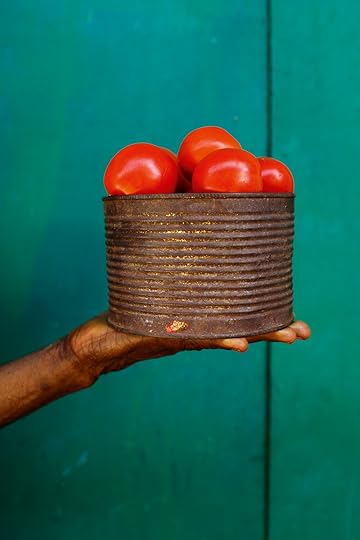 Misper Apawu, Hannah Korkor, tomato seller, 2023
Misper Apawu, Hannah Korkor, tomato seller, 2023 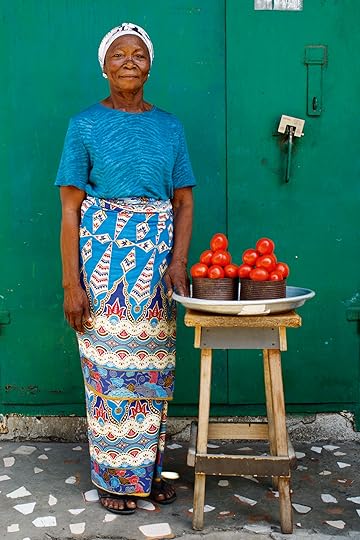 Misper Apawu, Hannah Korkor, tomato seller, 2023
Misper Apawu, Hannah Korkor, tomato seller, 2023 Makola is located in Accra’s central business district, and since being built in 1924 it has been dominated by women. Historically, women from Accra’s indigenous Ga ethnic group, who had been trading since the sixteenth century, made Makola a thriving market. Makola is now a much more diverse place, with women from all over Ghana participating in the trading business. Many, including Winnifred Aku Tetteh, a smoked-fish seller, have been working in Makola for more than thirty years. They supply Accra’s five million residents with fresh produce, household supplies, clothing, and everything else for their daily needs. The women’s success depends on their ability to read cultural shifts and use of a range of marketing techniques while keeping up with global trends. For example, wax print sellers, such as Veronica Agbozo, who source their fabrics and lace from the United States, China, Nigeria, and Togo, among other places, rely on their storytelling skills—beginning with the naming of new patterns to reflect Ghanaian sociocultural realities—to help sell their products.
 Aperture Magazine Subscription 0.00 Get a full year of Aperture—and save 25% off the cover price. Your subscription will begin with the summer 2023 issue, “Being & Becoming: Asian in America.”
[image error]
[image error]
Aperture Magazine Subscription 0.00 Get a full year of Aperture—and save 25% off the cover price. Your subscription will begin with the summer 2023 issue, “Being & Becoming: Asian in America.”
[image error]
[image error] 
In stock
Aperture Magazine Subscription $ 0.00 –1+ View cart DescriptionSubscribe now and get the collectible print edition and the digital edition four times a year, plus unlimited access to Aperture’s online archive.
Last spring, the Accra-based photographer Misper Apawu made repeated trips to Makola to produce a series of portraits of women traders. Apawu, whose work has often focused on the lives of women in Ghana, claims that her first encounter with photography occurred in a market in Dambai, a town in the Oti region of Ghana, an experience that changed her life. In her childhood, when she used to sell iced water in the market, she watched the women’s faces light up whenever tourists pointed their cameras at them. And when tourists showed the women their pictures, they would beam with delight. The joy Apawu witnessed between the women and the camera inspired her to take up photography as a young adult.
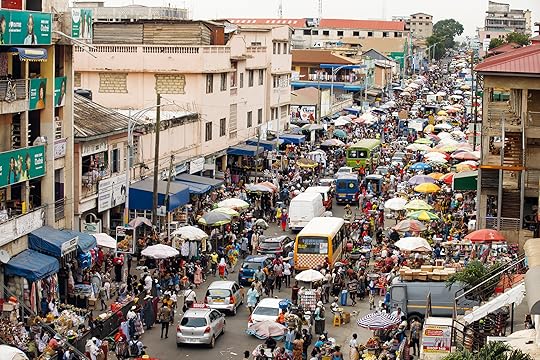
Misper Apawu, Makola Market, 2023
var container = ''; jQuery('#fl-main-content').find('.fl-row').each(function () { if (jQuery(this).find('.gutenberg-full-width-image-container').length) { container = jQuery(this); } }); if (container.length) { const fullWidthImageContainer = jQuery('.gutenberg-full-width-image-container'); const fullWidthImage = jQuery('.gutenberg-full-width-image img'); const watchFullWidthImage = _.throttle(function() { const containerWidth = Math.abs(jQuery(container).css('width').replace('px', '')); const containerPaddingLeft = Math.abs(jQuery(container).css('padding-left').replace('px', '')); const bodyWidth = Math.abs(jQuery('body').css('width').replace('px', '')); const marginLeft = ((bodyWidth - containerWidth) / 2) + containerPaddingLeft; jQuery(fullWidthImageContainer).css('position', 'relative'); jQuery(fullWidthImageContainer).css('marginLeft', -marginLeft + 'px'); jQuery(fullWidthImageContainer).css('width', bodyWidth + 'px'); jQuery(fullWidthImage).css('width', bodyWidth + 'px'); }, 100); jQuery(window).on('load resize', function() { watchFullWidthImage(); }); const observer = new MutationObserver(function(mutationsList, observer) { for(var mutation of mutationsList) { if (mutation.type == 'childList') { watchFullWidthImage();//necessary because images dont load all at once } } }); const observerConfig = { childList: true, subtree: true }; observer.observe(document, observerConfig); }Women in Ghana’s markets have built and expanded their businesses on centuries-old systems, including apprenticeships. Alberta Koshie Lamptey, a bead seller, and Lydia Owusu, an avocado seller, learned the trade from their mothers. Makola has changed since they took over their stalls more than a decade ago, with an increased number of traders, higher costs of goods, and the lack of a credit system. Like women in markets throughout Ghana, they are grateful for their jobs, financial independence, and the ability to provide for their families. For women such as Elizabeth Darkwa Mensah, Makola has given her not only financial freedom but the opportunity to lead. As president of a wax print sellers’ association in Makola, she is part of a team of market queens who manage market facilities, enforce rules, provide financial support, respond to emergencies, and create networking opportunities. Makola, like other markets, is underfunded and underresourced, but its leaders ensure that it runs smoothly.
Advertisement
googletag.cmd.push(function () {
googletag.display('div-gpt-ad-1343857479665-0');
});
As influential and visible players in the economy, market women bear the brunt of rising prices, which are often caused by inflation and poor fiscal management. During the 1979 economic crisis, both the government and Ghana’s citizens blamed Makola’s sellers for rising prices and shortages of essential goods, and for that the market was demolished by soldiers. Elizabeth Darkwa Mensah still remembers the trauma and the challenges that followed when trading resumed in 1987, and she is thankful that Makola has transitioned into a thriving commercial hub in Accra.
 Misper Apawu, Winnifred Aku Tetteh, smoked-fish seller, 2023
Misper Apawu, Winnifred Aku Tetteh, smoked-fish seller, 2023 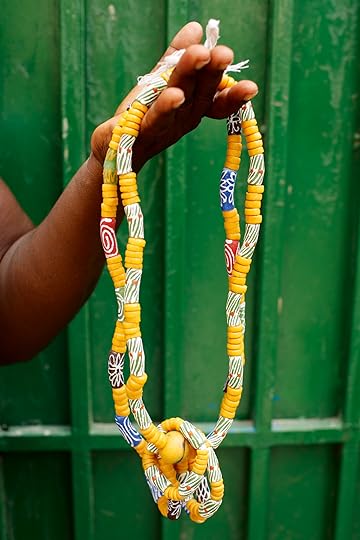 Misper Apawu, Alberta Koshie Lamptey, bead seller, 2023
Misper Apawu, Alberta Koshie Lamptey, bead seller, 2023 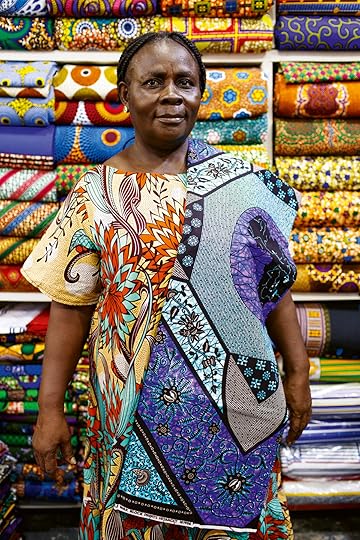 Misper Apawu, Veronica Agbozo, textile seller, 2023
Misper Apawu, Veronica Agbozo, textile seller, 2023  Misper Apawu, Lydia Owusu, avocado seller, 2023
Misper Apawu, Lydia Owusu, avocado seller, 2023 This article originally appeared in Aperture, issue 252, “Accra.”
Aperture Honors Dawoud Bey for 2023 Gala
On October 3, Aperture celebrated the 2023 Gala, its most prominent annual benefit supporting Aperture’s mission and belief that photography can inspire a more curious, creative, and equitable world. The evening signaled a transformational moment for Aperture, with an upcoming move to the Upper West Side, expanding visibility and reach for the seventy-one-year-old nonprofit organization. The Gala also marked a joyous occasion for Aperture supporters and artists to gather in tribute to a beloved force in the field—photographer, educator, and MacArthur Fellow Dawoud Bey. In remarks at the event, Aperture Executive Director Sarah Meister described Bey, who is also an Aperture Trustee, as “a North Star for the organization.” She continued, “If Aperture is dedicated to creating insight, community, and understanding through photography, then there is no one who exemplifies that more than Dawoud.”
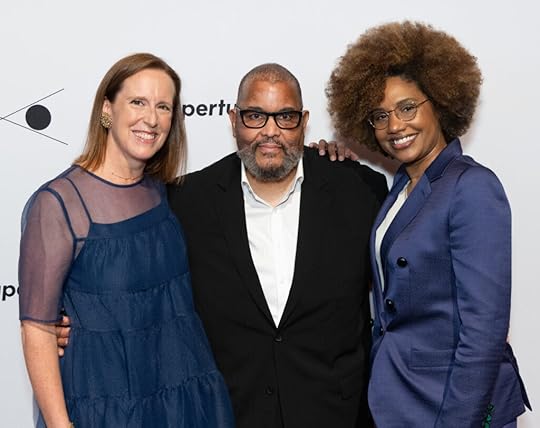 Sarah Meister, Dawoud Bey, and LaToya Ruby Frazier
Sarah Meister, Dawoud Bey, and LaToya Ruby FrazierThe Gala was graciously cochaired by Agnes Gund and Aperture Trustees Elizabeth Ann Kahane, Cathy M. Kaplan, Dr. Kenneth Montague, Bob Rennie, and Lisa Rosenblum. Guests arriving at the Ertegun Atrium at Jazz at Lincoln Center were greeted by the cochairs, served sparkling drinks, and had the opportunity to view and bid on works in an auction.
Live music by the Harlem Renaissance Orchestra welcomed guests into the Appel Room for a seated dinner with an early autumnal menu. Aperture Board Chair and Gala Cochair Cathy Kaplan thanked the many friends and colleagues for their ongoing support and alliance with Aperture, which was followed by a spirited tribute to Dawoud Bey’s legacy as an artist and activist.
For decades, Dawoud Bey (born in Queens, 1953) has made evocative photographs that mine the histories of marginalized Black communities, with works ranging from the side streets and thoroughfares of Harlem, the 16th Street Baptist Church in Birmingham, and the dense, unmarked trails of the Underground Railroad. His forthcoming Aperture publication, Elegy (copublished with the Virginia Museum of Fine Arts), assembles the history projects and landscape-based work Bey has made since 2012, and is being published in conjunction with a new exhibition. In admiration ofBey’s impact on modern visual culture, his friend, artist Carrie Mae Weems contributed for the video program: “Thank you for the way in which you’ve brought other photographers forward. You’ve made space for others. You’ve given us something special through your life’s work, and for that I am deeply grateful.”

Gala cochairs: Lisa Rosenblum, Elizabeth Kahane, Bob Rennie, Dawoud Bey, Agnes Gund, Kenneth Montague, Cathy Kaplan, and Sarah Meister

Kwame S. Brathwaite, Colette-Veasey Cullors, Laurie Cumbo, Dawoud Bey, Hank Willis Thomas, Kenneth Montague, and Sarah Meister
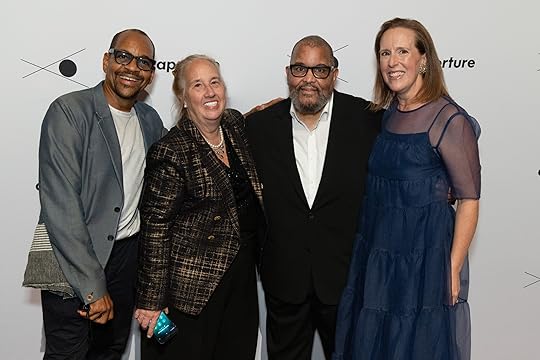
Lyle Ashton Harris, Gale Brewer, Dawoud Bey, and Sarah Meister
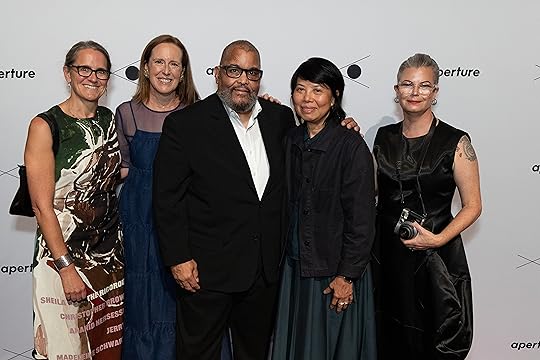
Natasha Egan, Sarah Meister, Dawoud Bey, An-My Lê, and Lesley A. Martin

Pamela and Lennell Myricks, Sarah Meister, Dawoud Bey, and Tom Schiff

LaToya Ruby Frazier, Dawoud Bey, Carrie Mae Weems, and Sarah Meister

Elizabeth Kahane, Dawoud Bey, and Stuart Cooper
Previous NextAdditionally in the video tribute, artist Tyler Mitchell and Elisabeth Sherman, curator at International Center of Photography, shared experiences that illustrate Bey’s dedication and practice. On stage, fellow artist LaToya Ruby Frazier admired her colleague’s virtuosic ability to capture both the historic and everyday rhythms of Black life. During her introduction of Bey, Frazier remarked, “To encounter you, is to elevate in confidence, rigor, and thought what it means to be a photographer, what it means to be an artist, the discipline and commitment it takes.”
With performances from the Harlem Renaissance Orchestra, the evening included powerful remarks from Laurie Cumbo, New York City Commissioner of Cultural Affairs, and Gale A. Brewer, New York City Councilmember representing the Upper West Side neighborhood where Aperture will soon establish a new permanent home. Also joining were many artists who have collaborated with Aperture on publications and programs in support of their work over the years, such as Kelli Connell, Sara Cwynar, Angélica Dass, John Edmonds, Awol Erizku, Adam Fuss, Phyllis Galembo, Gail Albert Halaban, Lyle Ashton Harris, Tommy Kha, Justine Kurland, Gillian Laub, An-My Lê, Jarod Lew, Missy O’Shaughnessy, Ari Marcopoulos, Ryan McGinley, Susan Meiselas, Joel Meyerowitz, Philip Montgomery, Matthew Pillsbury, Stephen Shore, Paul Anthony Smith, Rosalind Fox Solomon, Joel Sternfeld, Hank Willis Thomas, Alex Webb, Rebecca Norris Webb, author and curator Nicole R. Fleetwood, and writer Rebecca Bengal.
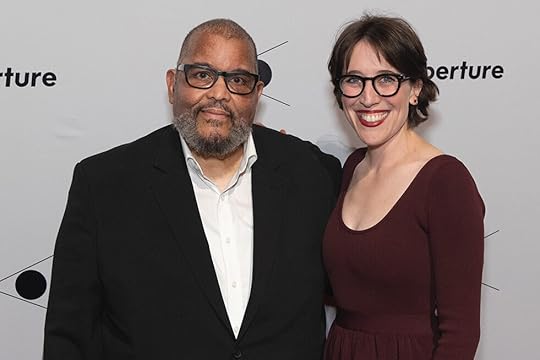 Dawoud Bey and Elizabeth Sherman
Dawoud Bey and Elizabeth Sherman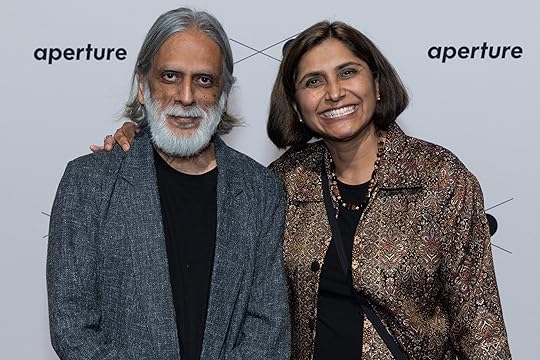 Vasant Nayak and Sheela Murthy
Vasant Nayak and Sheela Murthy Harlem Renaissance Orchestra
Harlem Renaissance Orchestra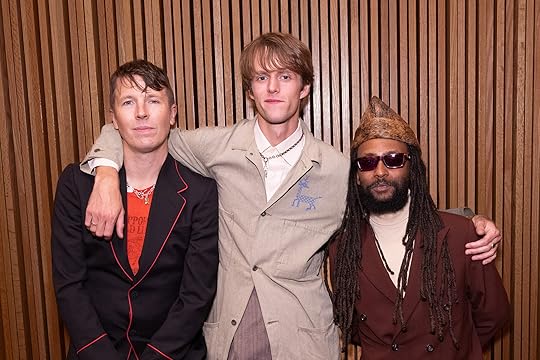 Ryan McGinley, Marc Domingo, and Awol Erizku
Ryan McGinley, Marc Domingo, and Awol Erizku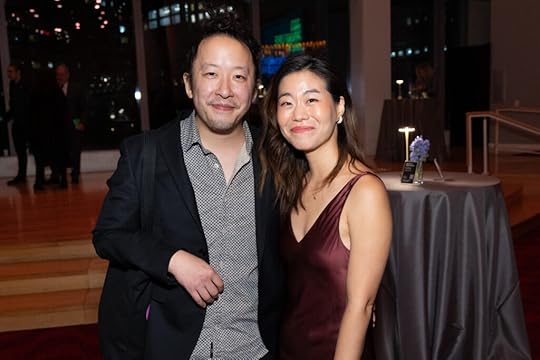 Jarod Lew and Sunny You
Jarod Lew and Sunny You Remi Onabanjo, Leigh Raiford, and Lucy Gallun
Remi Onabanjo, Leigh Raiford, and Lucy Gallun Jon Stryker, Biljana Simic, and Slobodan Randjelović
Jon Stryker, Biljana Simic, and Slobodan Randjelović  Cathy Kaplan
Cathy Kaplan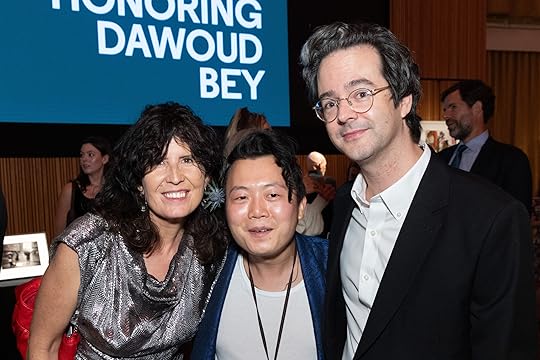 Rebecca Bengal, Tommy Kha, and Michael Famighetti
Rebecca Bengal, Tommy Kha, and Michael Famighetti Ari Marcopoulos and Kara Walker
Ari Marcopoulos and Kara WalkerThe night also featured a live auction, animated by Sarah Krueger, Head of Photographs at Phillips, with an impressive lot of works by Dawoud Bey, Kwame Brathwaite, Gordon Parks, Gregory Crewdson, and Justine Kurland. A silent auction, hosted on Artsy through noon on October 4, included work by Jamel Shabazz, Joel Meyerowitz, Gail Albert Halaban, Garry Winogrand, An-My Lê, Lillian Bassman, Shirin Neshat, Erwin Olaf, Vik Muniz, and Robert Polidori. A paddle raise to benefit Aperture’s work scholar program which offers invaluable career development and experience in arts and publishing, inspired a swell of contributions from Gala attendees. Proceeds from the Gala and auction support Aperture’s work as a nonprofit leader in the field, including its award-winning publications, educational initiatives, exhibitions, and public programming. Those attending the Gala as well as those reading along in support are encouraged to make a donation of any amount here.
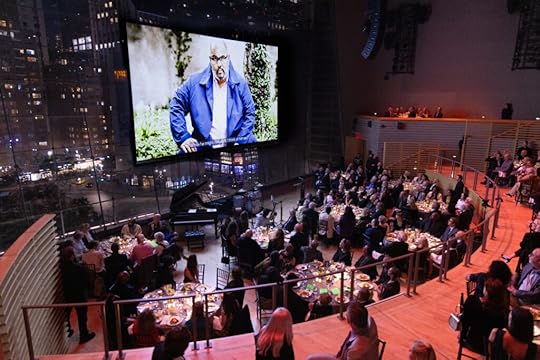
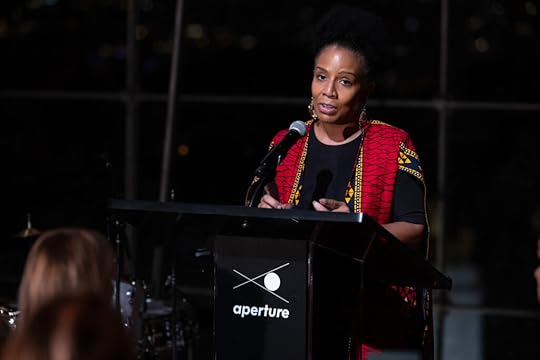 Commissioner Laurie Cumbo
Commissioner Laurie Cumbo Joel Meyerowitz and Clark Winter
Joel Meyerowitz and Clark Winter Elizabeth Gregory Gruen, Kellie McLaughlin, Bob Gruen
Elizabeth Gregory Gruen, Kellie McLaughlin, Bob Gruen Denise Wolff and Marvin Heifernan
Denise Wolff and Marvin Heifernan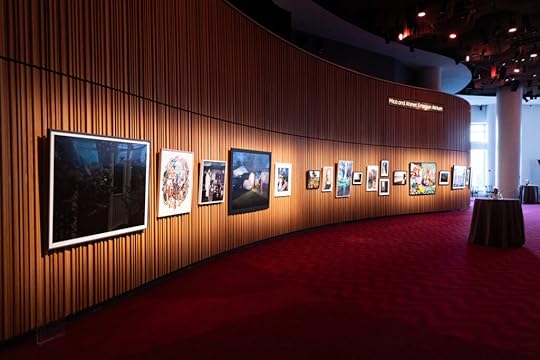
Aperture’s 2023 Gala thanks Founders Agnes Gund, Judy and Leonard Lauder, Lisa Rosenblum, Thomas R. Schiff and Mary Ellen Goeke; Gala Leaders Dawoud Bey, Allan Chapin and Anna Nilsson, Emerson Collective, Goldman-Sonnenfeldt Foundation, Elizabeth and William Kahane, Cathy M. Kaplan and Renwick D. Martin, Melissa and James O’Shaughnessy, and Sean Kelly Gallery. Thanks to those who made the auction possible, including Dawoud Bey, Sean Kelly Gallery, The Gordon Parks Foundation, Kwame S. Brathwaite and the Brathwaite Archive, Michael Hoeh, Gregory Crewdson, and Justine Kurland and Higher Pictures.
Related Items
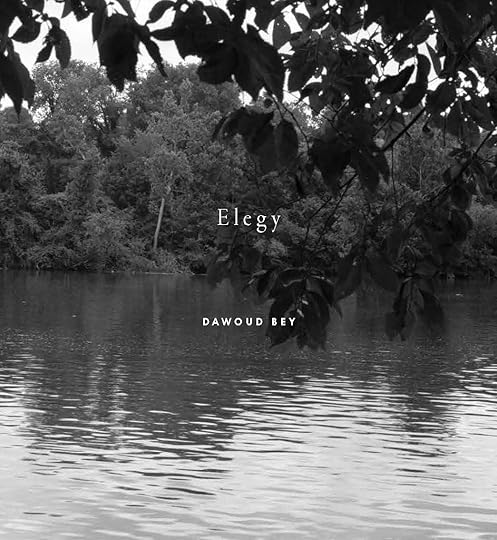
Dawoud Bey: Elegy
Shop Now[image error]
Dawoud Bey on Photographing People and Communities
Shop Now[image error]September 29, 2023
How Archives Illuminate the History and Culture of Ghana
The first time I heard of a photographic archive in Ghana was in 2009 after returning to Accra following studies in London. I was the editor of Dust, a quarterly love letter to Accra that documented the city’s (then) nascent cultural scene. We were drafting an article about one of our inspirations—the iconic South African magazine Drum (which published photography by the likes of Ernest Cole and James Barnor in the 1950s and 1960s)—when my photo-editor, Seton Nicholas, mentioned the Willis Bell Archive.
Bell, an American photographer who died in 1999, snapped thousands of images during a long residence in postindependence Ghana, including commissioned photographs of Ghana’s first leader, Kwame Nkrumah. Those photographs are currently being restored and digitized by the Mmofra Foundation, a nonprofit organization continuing the work of Bell’s close friend Efua Sutherland, a playwright who was one of Ghana’s first and most prominent cultural activists and advocates for children. Mmofra (which means “children” in Akan) runs a beautiful park on the Sutherland compound, where Bell once lived, and is dedicated to the cultural and intellectual enrichment of Ghana’s children.
 Deo Gratias studio, Accra, 2023
Deo Gratias studio, Accra, 2023Photograph by Francis Kokoroko for Aperture
 Photographic City, Agbozume, Group of friends photographed at the beach, Volta Region, 2000s
Photographic City, Agbozume, Group of friends photographed at the beach, Volta Region, 2000s© and courtesy the artist and Saman Archive
There are, of course, other archives in a land as visually compelling as Ghana. Photographs were once a marker of social status here, and many elite Ghanaian families have flocked to places such as Accra’s Deo Gratias, one of Ghana’s oldest photographic studios, to immortalize themselves. Deo Gratias (Latin for “thanks to God”) was founded by the photographer J. K. Bruce-Vanderpuije in 1922. Born to a wealthy family in 1899, he opened the studio after a three-year apprenticeship under the photographer J. A. C. Holm. The firm made portraits of British and Indian families as well as Black professionals, then expanded to cover corporate events. Bruce-Vanderpuije was later joined by one of his sons, Isaac, also a gifted photographer. Deo Gratias, situated in a graceful old building in the heart of Jamestown, one of the city’s first districts, is surrounded by history: it is walking distance from a lighthouse, two colonial-era forts, and a palace. It is run today by Kate Tamakloe, who builds on her father’s and grandfather’s work by scanning and digitizing pictures from old film and glass plates.
Tamakloe considers archives such as Deo Gratias to be vitally important in Africa, where history is often ignored, forgotten, or obscured. The introduction of photography in West Africa in the mid-nineteenth century would ultimately give Ghanaians a better appreciation of the landmark events of independence a hundred years later. The photographs housed at Deo Gratias “prove history, occasion, and even lifestyle,” she says, and, in turn, inspire books, films, and documentaries. One might think that this would make the archiving of photography a national priority, but Tamakloe explains that individual Ghanaians have always been more supportive of photography than any of Ghana’s myriad political administrations.
 Aperture Magazine Subscription 0.00 Get a full year of Aperture—and save 25% off the cover price. Your subscription will begin with the summer 2023 issue, “Being & Becoming: Asian in America.”
[image error]
[image error]
Aperture Magazine Subscription 0.00 Get a full year of Aperture—and save 25% off the cover price. Your subscription will begin with the summer 2023 issue, “Being & Becoming: Asian in America.”
[image error]
[image error] 
In stock
Aperture Magazine Subscription $ 0.00 –1+ View cart DescriptionSubscribe now and get the collectible print edition and the digital edition four times a year, plus unlimited access to Aperture’s online archive.
That said, one of Ghana’s most important repositories, the J. H. Kwabena Nketia Archives, part of the University of Ghana, benefits, at least indirectly, from government support. Currently run by Judith Opoku-Boateng, the archive is named after Joseph Hanson Nketia, Africa’s foremost ethnomusicologist until his passing in 2019, at the age of ninety-seven. Its contents include music from all over Africa—priceless recordings of vanishing traditions—as well as the Institute of African Studies’ historical records dating as far back as the 1960s, and a large photographic collection of postcolonial Ghana. It is the largest and most systematic set of recordings of any African ethnomusicologist, initially spanning forty years of field research by Nketia and his colleagues, and documents sounds, stories, and songs across the length and breadth of Ghana, along with oral and performance traditions of the numerous peoples within (and sometimes beyond) its borders. Recent initiatives to grow the collection have included the gathering of special historical papers, photographs, and other audiovisual materials from the families of other deceased scholars. Nketia was the first to capture practices passed down for generations through oral tradition. While his association with music means that the archive may be known primarily for its traditional and highlife recordings, it also houses thousands of negatives and prints that capture the lives of Ghanaians of all walks of life at a crucial time in our history.
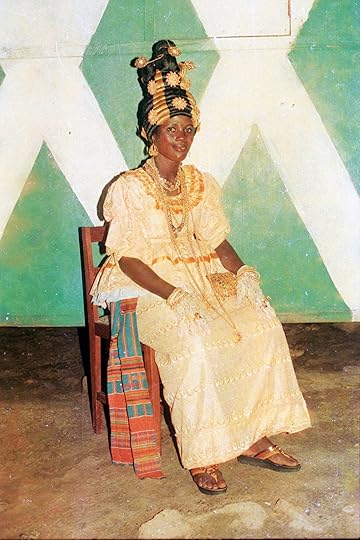 Jacob Quaye Mensah, Woman photographed at a wedding, Apam, Ghana, ca. 1990s
Jacob Quaye Mensah, Woman photographed at a wedding, Apam, Ghana, ca. 1990s© and courtesy the artist and Saman Archive
 Independence Day Parade, Accra, early 1960s
Independence Day Parade, Accra, early 1960s© Mmofra Foundation, Accra, and courtesy Willis Bell Photographic Archive
Although it feeds from the budget allocated to the Institute of African Studies by the University of Ghana, Opoku-Boateng explains that funding is still barely sufficient for the smooth running of the complex equipment and logistics required by the archive. Another challenge is understaffing: besides Opoku-Boateng and two senior research assistants, one of whom is part time, the archive relies on interns. There is also the problem of obsolescence, with much of the information being stored on analog media formats and requiring playback equipment unavailable in Ghana, “leaving the value of these materials totally locked up.”
Photographs are no longer exclusive to high Ghanaian society. I remember how hard it was to get one’s photograph taken while growing up in 1990s Cape Coast, Ghana’s former capital. My boarding-school mates and I would pool together pocket money, and one of us would make a beeline to the nearby photo studio to book an appointment for the following weekend, when we would pose in our best school uniforms. Then we would wait—for as long as a month—for our pictures to be developed and printed. Unlike for today’s middle-class Ghanaians, who grow up capturing their entire lives on mobile phones to share on social media, there are reasons why many in my generation lack the millennial impulse to document the mundane.

Deo Gratias studio, Accra, 2023
Photograph by Francis Kokoroko for Aperture
Tamakloe expresses skepticism for online platforms such as Instagram and the dominance of digital. “We have lost all the technicalities of a beautiful photograph, even knowledge of the long process of using chemicals in the darkroom,” she says. “Today, it’s plug and play. Once the photo is not blurry, it’s considered ‘a good shot.’” Nevertheless, some do attempt to harness the power of these platforms for the greater good. One such entity is Si Hene—a reference in Akan to the enstoolment of royalty—which was founded in 2020 as a website and Instagram account by Rita Mawuena Benissan, a Ghanaian American interdisciplinary artist who describes Si Hene as “an archive-based collection of images of Ghanaian chieftaincy.” Such work is important in the context of a continent whose royals were reduced from kings and queens to “chiefs” by colonizers whose worldview stopped them from seeing Africans as equals.
When I visited Benissan at Gallery 1957, a contemporary art space and commercial gallery housed in Accra’s Kempinski Hotel, she was preparing for an exhibition at the gallery on the elaborately designed umbrellas that provide more than mere cover from sun and rain to Ghanaian chiefs during royal durbars and festivals. (In Ghana, such umbrellas, as much symbols of royalty as any crown or scepter, are used during sacred traditional ceremonies and festivals.) Benissan tells me that she sees her exhibition and online archiving as extensions of the same work. “People say ‘chieftaincy is dead,’ but it’s not. Literally everything we do is derived from chieftaincy: from our stools to our names to the kente we wear to how we style our hair and present ourselves. It all comes from the chieftaincy. The photos are a way to bridge that heritage.”
Photography has changed from focusing on members of high society to becoming a people’s visual history.
She has been inspired by others including Amy Sall, founder of SUNU Journal—an independent, Pan-African, postdisciplinary multimedia platform that publishes works dealing with Africa and its diaspora—as well as by Nana Oforiatta Ayim, a Ghanaian art historian, and Deborah Willis, the African American historian of photography who once invited Benissan to a “life-changing” conference on Black portraiture at New York University. Benissan was struggling to find images of royal umbrellas for her US graduate-school research. Out of this frustration Si Hene was born. “Even though I had a lot of books,” Benissan explains, “there were no old images, only pictures of recent chiefs, or images from Benin and Nigeria but not Ghana.” Wanting to find out more about how these umbrellas were designed in the early 1800s and 1900s, she scoured archives at museums, institutions, and universities; family albums; and YouTube and internet resources, including Tumblr, to find the answer. It was hard work. “Sometimes, I could spend five hours looking for a photo and not find anything. But then you change a keyword, an image pops up, and you spend six more hours from that one connection,” Benissan tells me.
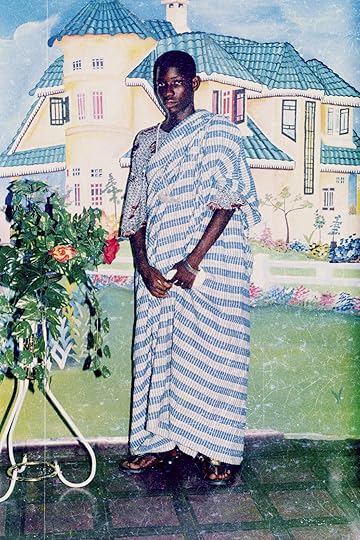 Perseverance Photo Studio, Teenage boy photographed with studio backdrop, Anloga, Ghana, 2000s
Perseverance Photo Studio, Teenage boy photographed with studio backdrop, Anloga, Ghana, 2000s© the artist and courtesy Saman Archive
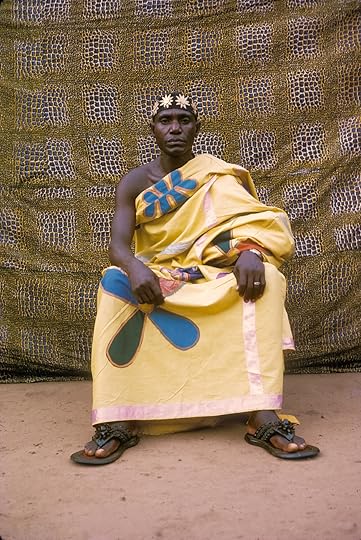 Portrait of Nana Kofi Yeboah, the Akrofromhene, 1970
Portrait of Nana Kofi Yeboah, the Akrofromhene, 1970Courtesy D. Michael Warren Papers, University of Iowa Libraries Special Collections and Archives, and Si Hene
After the COVID lockdowns lifted, Benissan returned to Ghana and gained access to chieftaincy meetings, where she was guided toward reference materials and archival collections that included pictures, postcards, stamps, and stills. She is seeing a slow rise of chiefs building their own museums, but she wonders whether these are aimed at Ghanaians or visitors from Africa’s diaspora trying to better understand the ancient nations and cultures out of which their ancestors were stolen. It is an important question: Africans in the diaspora have access to museums, universities, and other institutions their cousins in Africa lack. In Ghana, Benissan explains, you have to ask “a hundred people” for that kind of information, you have to wait and seek approval. Accessibility afforded by social media is key, but Benissan also notes that many parents, grandparents, and chiefs are not on Instagram. She describes being introduced to chiefs who appreciate her idea but ask an important question: “How do I see it?” She also faces copyright issues, as Si Hene does not own any of these images. She nevertheless tries to contact as many institutions, curators, and families as she can. Even if some do not respond, others, Benissan says, “seem happy we are providing another accessible way to see their collections.”
Advertisement
googletag.cmd.push(function () {
googletag.display('div-gpt-ad-1343857479665-0');
});
Similar in digital form to Si Hene stands Saman Archive, named after an Akan word that simultaneously means “ghost” and “photographic negative.” Founded in 2015 by the artist and writer Adjoa Armah, Saman began as a repository for the thirty thousand negatives dating from 1963 to 2010 that Armah collected from studios and photographers across Ghana as part of her practice-led doctoral research at the University of Oxford. She considers Saman to be more than just a collection of negatives, stating that the project is a place for “my own photographs and those of my collaborators across the country, recorded conversations with photographers, ephemera, and the research conducted as negatives are being collected.”
 Album covers, clockwise from top left: Kelenkye Band, Moving World, 1974; Ogyatanaa Show Band, Yerefrefre, 1975; African Brothers Band (International), Afrohili Soundz, 1973; Canadoes Super Stars of Ghana led by Big Boy Dansoh, Afaa Boatemah, 1985
Album covers, clockwise from top left: Kelenkye Band, Moving World, 1974; Ogyatanaa Show Band, Yerefrefre, 1975; African Brothers Band (International), Afrohili Soundz, 1973; Canadoes Super Stars of Ghana led by Big Boy Dansoh, Afaa Boatemah, 1985Images courtesy Bokoor African Popular Music Archives Foundation (BAPMAF) and J. H. Kwabena Nketia Archives
 The archives at Deo Gratias studio, Accra, 2023
The archives at Deo Gratias studio, Accra, 2023Photograph by Francis Kokoroko for Aperture
Saman stands on the shoulders of giants. As Armah explains, “We never start from zero. The best we can do is honor those who came before us.” She values Deo Gratias and holds particular appreciation for the Nketia Archives’ custodianship of Ghanaian sonic histories, saying, “It’s their work and the work that families do, in which the stories around photographs are central, that really influence me.” In contrast to Si Hene, Saman’s areas of collecting go beyond chieftaincy, and its public face is a website. Noting the way photography has changed from focusing on members of high society to becoming a people’s visual history, Saman is, she says, “interested in what lives looked like beyond the grand narratives that cater toward middle-to-upper-class people.”
Armah surprises me with a “two-hundred-year plan” that includes eventually housing Saman in a physical space. Benissan also dreams of museum and research institutions, where physical images can be better preserved, in all sixteen regions of Ghana. She points out that chieftaincy palaces are ultimately homes and, as such, cannot offer visitors the same levels of exposure as museums. The goal is to balance access to the physical images housed in these spaces with respect for royal privacy. While Deo Gratias already serves as a physical museum, it, too, encounters problems of scaling up, a process that involves, as Tamakloe explains to me, “maintaining the glass plates, digitizing them totally, and making it available virtually to the world to tell the Ghanaian story.” Ghana’s archives are invaluable resources for understanding the nation’s past. Ongoing efforts to preserve and digitize such records—both physical objects and data—are essential for future generations. This work is shaping a collective understanding of history and identity that may otherwise be lost in the maelstrom of modern culture: a thing that is never static.
This article originally appeared in Aperture, issue 252, “Accra.”
Carrie Schneider Unspools a Riddle about Photography and Cinema
In the vast former-factory space of MASS MoCA, a singular, inscrutable, sculptural photograph, titled Madame Psychosis (Joelle van Dyne) (2023) and measuring an astonishing forty inches by eight hundred feet, unfurled in a seemingly endless scroll, pitched in a roof formation at its peak and rippling out over a large plinth. Another work (Infinite Kill, 2023) cascaded across the gallery’s walls. In the adjacent spaces, one room displayed more than a hundred dreamlike, abstract photographs—multiple exposures of images sourced from a litany of artists, films, and social-media feeds of the artist’s friends, layered onto personal images. Lurid with color, all were photographed and rephotographed in dark, transitory, predawn hours. Here, they were installed with little wall space separating each of them, emphasizing their shared connection. And projected in the back room is a 16mm film that exudes a Warholian Screen Tests energy. Composed of stills showing the actor Romy Schneider, the work flickers on the walls so that Romy seems to watch her own image scatter around.
The film is Carrie Schneider’s Sphinx (the answer isn’t man) (2023). Sphinx is also the title of her solo exhibition at MASS MoCA, which was on view from March to September 2023, and featured work that the Brooklyn and Hudson, New York–based artist made beginning in the spring of 2020. All Schneider’s vivid, sometimes gigantically large photographs were made with a room-size camera that she built herself out of industrial plastic and outfitted with a Rodenstock lens. (Some of the pieces have been shown at Candice Madey and Chart galleries in New York.) As in previous series that incorporate self-portraiture, personal traces of and references to the artist were present in Sphinx too. There’s Romy Schneider, who shares the artist’s surname, in the film, and in Infinite Kill, where she appears on a phone screen that the artist cradles in one hand, nails painted bright red, and holds up to the camera. Revenge Body (2022), a floor-to-ceiling photograph of a repeated abstracted still from the 1976 film Carrie, depicts Sissy Spacek’s title character, who shares the artist’s first name, her face dripping with blood.
 Installation view of Carrie Schneider: Sphinx at MASS MoCA, 2023. Photograph by Jon Verney
Installation view of Carrie Schneider: Sphinx at MASS MoCA, 2023. Photograph by Jon VerneyOn the surface, the pieces that made up Sphinx represent a radical and monumental shift in scale, material, and conception within Schneider’s practice, but also in thinking about photography itself. This is work that particularly invites and rewards close looking, revealing subtle and surprising connections with many of Schneider’s previous series of photographs and videos, from Burning House (2012–13)—for which she built to scale a small house on a tiny island, set it aflame, and filmed its burning—to her numerous collaborations, including those with the choreographer and dancer Kyle Abraham, artist Abigail DeVille, and composer and musician Cecilia Lopez.
I first met Schneider in 2009, when we were both in residence (in visual arts and fiction, respectively) at the Atlantic Center for the Arts, where Rineke Dijkstra was a visiting master artist. A few years later, I participated in Reading Women (2012–14), comprising immersive photographic and video portraits of a hundred of her women-identifying friends and peers reading books by other women in their homes or studios. There’s a clear path, it seems to me, from Reading Women to Sphinx. As artist and filmmaker Cauleen Smith (who also participated in the former project) wrote in a 2014 essay titled “Carrie Schneider’s Grown-Ass Women: You Better Recognize”: “She sits with her. She lets her be. Like a thermal current on a cool day the condensation of a woman into a being of pure thought, silent and in violent motion at the atomic level offers mad quotients of marvel. A woman reading is not accessible or controllable. We cannot know what she might do. We are left to wonder.”
Unraveling and unfurling their inner selves, reclaiming how they are seen, the works in Schneider’s Sphinx similarly unspool their riddles before us. Recently, Schneider and I spoke about the process of making Sphinx and discussed its influences, ranging from Imogen Cunningham to renowned film theorist Laura Mulvey, author of the landmark essay “Visual Pleasure and Narrative Cinema,” and creator of films including Riddles of the Sphinx (1977).
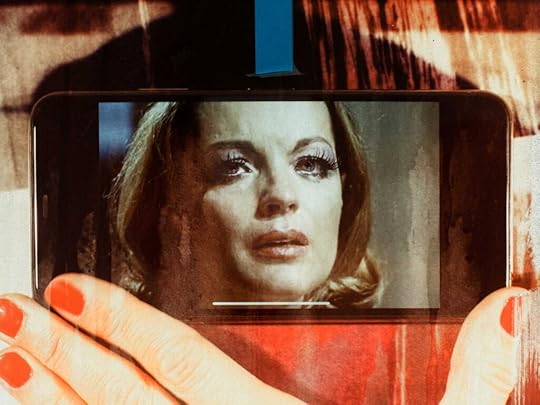 Carrie Schneider, Sphinx (the answer is man), 2023
Carrie Schneider, Sphinx (the answer is man), 2023Rebecca Bengal: Congratulations again on such a brilliant exhibition and catalog—which has stayed so much on my mind since I got to visit earlier this summer. I’m curious how the exhibition changed for you during the span of its run.
Carrie Schneider: Thank you! It was so fresh when I installed the work. My studio is a renovated one-car garage, so there was no way for me to test out these large sculptures. I had been making them in this camera that I built, exposing hundreds and hundreds of feet of this color chromogenic paper—there’s something like 4,600 feet of paper in all in the show—but until we installed, they existed as a plan in my mind of what I wanted to make.
I installed for two weeks straight with a crew of twelve people, and it really extended the way that I thought about the work immediately. It just exploded my brain. I felt like suddenly I had twenty-four arms, and it also really made me think of the next six projects I’ll make. I’m still unpacking what it was like for me to finally see it in this space: I feel like, when it opened, it was so new on the walls, that I really saw it as other people saw it. I’m still in a state of semi-confusion. It still feels very new to me, even though the show itself is almost over.
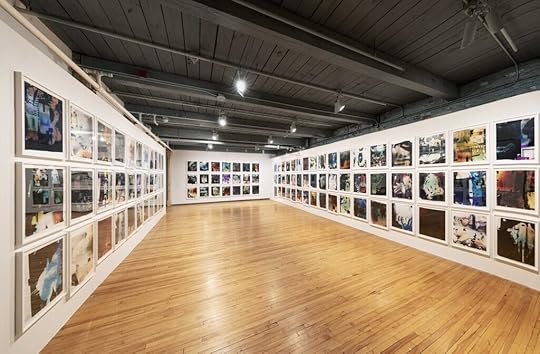 Installation view of Carrie Schneider: Sphinx, MASS MoCA, 2023
Installation view of Carrie Schneider: Sphinx, MASS MoCA, 2023Bengal: It’s true, even some of the first works in the exhibition feel so new in this context. I’m thinking of Deep Like (2020–21), your series of 105 pictures, all around twenty by twenty-five inches, which take up an entire room in the show. How did that work lead to the larger pieces?
Schneider: Those were the earliest kind of experiments. I think of them as being my alphabet for the language that I then develop in the larger works in the adjacent galleries. I was exposing this chromogenic paper through the lens of this camera that I built in my studio in the pandemic, and then I decided I wanted to scale up. So I made larger prints, I built my camera a little bit larger, just further exhausting the motifs. And then I really leaned into using an image that started in Deep Like: really looking at the face of the actress Romy Schneider.
There was a certain moment where I realized that didn’t need to cut the paper. It was coming in these long rolls, shipped to my home during the early pandemic. And instead of cutting the paper in the dark and putting it into my camera, it just dawned on me: I’ll just continue to advance the paper kind of frame by frame or bit by bit, exposing a continuous roll. That was, maybe about a year into making the work, when I had that realization that I wanted to just use the material in this way that was really structural, expanded into hundreds of feet-long photographs. And then I had to figure out how I would show them, how they would become became installations or sculptures, kind of coming off the wall.
 Carrie Schneider, Infinite Kill, 2022
Carrie Schneider, Infinite Kill, 2022Bengal: When and why did you decide to build your own camera?
Schneider: Before the pandemic I’d also been doing a side project where I was figuring out how to expose chromogenic paper through the camera’s lens, and filter it so that if I were to reshoot it as a paper negative, it would faithfully invert—achieving a kind of black-and-white and a neutral tone. And I had been making tests for years using a large-format Deardorff camera that I bought from a mentor.
I was ready for it to move to the next level. I really knew I wanted to scale up, and I’d been shopping around how to get a custom camera built. But the quotes I was getting felt prohibitively expensive, and of course it’s the pandemic, and everything was so demoralizing. One day I’m out on a run and I thought, suddenly, Oh my god, I know how to make a fucking camera! It’s just a light-tight box. It’s just a dark box. It doesn’t have to be beautiful. And that same day, I went to Home Depot with a mask on and bought all that stuff . . . I think it was something like $110 total. And I went home and I made it, and it completely worked, first try. What I’m working with now is maybe the sixth generation of it. It’s slightly bigger now. I call it my Frankencamera.
 Carrie Schneider, Still from Burning House, 2012–13. HD film, 12 minutes, color, sound
Carrie Schneider, Still from Burning House, 2012–13. HD film, 12 minutes, color, sound Carrie Schneider, Still from Burning House, 2012–13. HD film, 12 minutes, color, sound
Carrie Schneider, Still from Burning House, 2012–13. HD film, 12 minutes, color, soundBengal: It makes me think about the sculptural aspect of your work, especially projects like Burning House: the idea of a camera as a house.
Schneider: Exactly. They’re actually about the same size. And of course, camera means “room” in Latin.
Bengal: Your approach to this work is so intuitive and original, but I also know there’s some important inspirations for you lurking in its backstory.
Schneider: I really love everything about Imogen Cunningham’s work, but there are these two negative images in particular: one is of a snake, and one is of her friend Roberta. When I first saw that one, Roberta (Negative) (1961), about fifteen years ago, I thought, What is this? I immediately printed it out and put it on my studio wall. I think what she did is she just used a paper negative, kind of like a contact sheet in reverse. I just wanted more things like that to exist in the world.
Bengal: It’s such a cool and incredible picture. What else about it, specifically, drew you in?
Schneider: What I took from it as a kind of a stepping-off point is seeing how an image of a familiar thing in negative produces this really uncanny effect. I think the image of Roberta is just some textures, like plants and her face. It’s just that simple, but when they’re inverted and negative and kind of superimposed on one another, the results are so surprising. So what I took from that is that the magic didn’t really need to be made with much, but to just be open to experimenting with everyday things floating around. I didn’t feel like I had to go too far to find something that might produce something satisfying to me in a similar way.
I don’t know if I’ve made my Roberta (Negative) yet, but I feel it gave me permission to start really simply, just shooting from within a dark room out of a window. Just seeing how the world outside looked in negative. I think it was very, very simple at first, and then pretty soon after that I started getting a little more weird.
 Carrie Schneider, Jacob F, 2021
Carrie Schneider, Jacob F, 2021Bengal: With Deep Like, you sourced images from friends’ and others’ social-media feeds, starting when we were all a bit isolated in early pandemic days. Were you actively looking for images at first, or was it born out of mindlessly doomscrolling in that doomy era?
Schneider: I don’t think it was so conscious at first. When I’m teaching, I try to remind my students that it’s okay to work intuitively because you have this whole armature of theory, or the art history you’ve absorbed. In early pandemic no one was watching. I didn’t have any shows lined up. So, in a way, I was totally liberated.
I was working at this really fast clip. I had to work in complete darkness because I’m working with the chromogenic paper, which is totally light sensitive. I wasn’t able to totally black out my studio, and of course I couldn’t even have a safe light, so I had to work at night when there was no sunlight. I’d had some insomnia in the pandemic, and I was going to sleep when my then five-year-old son was, at eight p.m., and then I was waking up at three or four in the morning. This became my prime time. I think it’s really kind of a famous time of day for, like, mother-artists’ work. I think Sylvia Plath called it the blue hour—you know, before anyone wakes up, where you actually have time to yourself. I felt that really viscerally.
Related Items

Aperture Magazine Subscription
Shop Now[image error]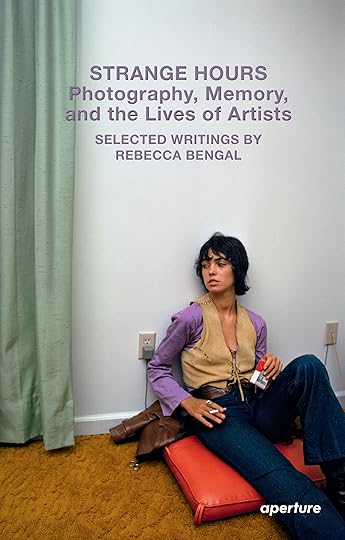
Strange Hours: Photography, Memory, and the Lives of Artists
Shop Now[image error]Bengal: I love those times. They can be super generative and freeing when the rest of the world is turned off. You have a beautiful artistic relationship to night, too, that’s there in your 2015 series Moon Drawings. Were there other discoveries you made from working these hours?
Schneider: Before I was a photographer, I was a painter, and so when I started this work, I was thinking about Sigmar Polke and the way he just exhausted motifs. He would appropriate something from somewhere and just make hundreds of photocopies of it, and they’d show up in paintings, these serigraphic images. It’s this different sort of engagement with Polke. It’s not like Warhol; it wasn’t a commentary on mass media or anything. It was just the weirdest, most idiosyncratic stuff. It emboldened me to do the same thing, and then there was this moment where I realized, Oh, these images that I’m reproducing, what if I then rephotographed those and those kind of invert yet again, and then I invert them again. I was really immersed in it.
 Carrie Schneider, Choose Well, 2022
Carrie Schneider, Choose Well, 2022  Carrie Schneider, tfw, 2022
Carrie Schneider, tfw, 2022 Bengal: So much of your work is cinematic in feeling and in origin, embodying these ideas that go back to Laura Mulvey, who introduced this idea of the male gaze—viewing a woman’s image as sexual object or giant threat.
Schneider: I’d had a Zoom studio visit with my friend Sarah, she had also studied with Laura, like I did at the Whitney Independent Study Program. And as we were talking, she said, “Have you read Laura recently? Maybe you should read her again.” And it was like, Oh my god, you’re so right. I mean, I hadn’t, like, in a decade. I went back, and I saw that the new work was illustrating this. It was so bizarre. Obviously, this was part of the armature upon which I’m building this work when I’m working intuitively, but it wasn’t conscious at all. When I reread her texts, I was just smacking myself on the forehead. You couldn’t do that, in a sincere way, to illustrate theory, but it felt so unbelievably parallel that I reached out to Laura and asked her if she’d meet with me on Zoom. We’ve had an ongoing conversation since then. She’s so sharp, and she’s writing about so many other things, too, and also updating texts she wrote that are now, like, forty-five years old.
She was telling me the other day how she was screening Citizen Kane for some people and when she was loading the film, it unspooled. It just spilled everywhere—but it also retained this form of the coil. There’s chaos, but it also somehow retains its form.
 Carrie Schneider, Eve of the Future, 2023. Installation view at MASS MoCA. Photograph by Jon Verney
Carrie Schneider, Eve of the Future, 2023. Installation view at MASS MoCA. Photograph by Jon VerneyBengal: Which was surely messy and maybe a little horrifying in the moment. But, as I also see it in the unspooling of your Sphinx, so vulnerable and exciting, to just lay it all bare and be. I think there’s a power in that. I also wanted to go back to something you said earlier, where you described your “alphabet of imagery.”
Schneider: I call it a seed-library impulse. At the start of making this work I was reading Octavia Butler’s Parable of the Sower, as so many people were. So, just the idea of preserving these creative influences, whether they were my peers or mentors or just different canonical works in the history of art, like this very idiosyncratic collection, but kind of preserving them in an analog form, just in case the digital technology could fail. There was something doomsdayish about it.
I also thought about it as, maybe that Mariah Carey clip [present in Schneider’s recent exhibition at Chart, I don’t know her] is, like, the golden record. To preserve some aspect of human culture and make this analog, as if we were sending it out into space. Putting it into a tangible form was a way of making a big statement about wanting to possess it or preserve it in a way.
Bengal: It feels to me also like a reclamation. To make your own camera. To articulate your own language. To take that all into your hands. To repossess those images and retranslate how they are seen. The immense space that the sphinx and Romy Schneider and Spacek-as-Carrie and all these women occupy in these rooms.
Schneider: When I kind of scaled up my camera, I started working in a way that felt much more loose. But also, sourcing these original images, it felt like it was something that could spin outwardly forever into these infinite possibilities, like in the way Agnes Martin could infinitely source a grid. For her the grid was so innocent and pure, like a tree. I felt like there was this really beautiful thing where I thought: I don’t have to go any further. I have it all right here, in this cache of images.
But also: if it is autobiographical, I think about the way Lauren Berlant said that the autobiographical impulse is inherently anxious and ambivalent. I think that’s kind of what drives it, that tension. There’s an element of possession and homage, but also theft.
 Carrie Schneider, Madame Psychosis (Joelle van Dyne) (detail), 2023
Carrie Schneider, Madame Psychosis (Joelle van Dyne) (detail), 2023All photographs courtesy MASS MoCA
Bengal: How did the physical process of making those giant prints affect the way you felt about and understood your own work?
Schneider: The owner of My Own Color Lab, where I printed all of it, and all of the employees—they went out of their way, stayed late, would help me run these massive things through. And just seeing, you know, that they even allowed me to do that is so rad. But also, their excitement about it was so motivating. I think it goes back to using all these technologies that require a lot of material knowledge but then using them in a way that they’re not meant to be used. That spirit of experimentation just made it all possible. The fact that they were even game to let me try to do it and were so psyched about it.
Bengal: There’s this inherent spirit of rebelliousness about that. How far can you extend this idea?
Schneider: What if this could just go on to infinity?
Carrie Schneider: Sphinx was on view at Mass MoCA through September 17. The accompanying catalog was published in 2023 by Hassla.
September 26, 2023
What It Means to Make Photographs as a Young Artist in Iran
Over the last century, photography in Iran has often been overshadowed by the country’s social and political conditions and historic flash points—among them the transition from the Qajar to the Pahlavi era in the 1920s, the Islamic Revolution in the late 1970s, and the Iran–Iraq War the following decade. As a result, many photographers, particularly those from the new generation who transcend geographical confines, have received relatively little recognition.
In countries where the art scene has attained a certain level of prosperity, there is a dynamic relationship between artists, curators, historians, and institutions. These elements collaborate to set the cycle in motion: the artist generates a piece of work, and curators exhibit these works in galleries and museums to explore new ideas. As a result, the artist’s work garners visibility, curators unearth innovative concepts, history advances, and ultimately, museums and galleries manage the economic aspects of this process. But young Iranian photographers encounter a distinct set of issues once they progress beyond the political imaginary.
 Zahra Motallebi, Untitled, 2021, from the series Disorders
Zahra Motallebi, Untitled, 2021, from the series Disorders  Zahra Motallebi, Untitled, 2023, from the series The Self-Taught Parrot
Zahra Motallebi, Untitled, 2023, from the series The Self-Taught Parrot While the significance of photography has only recently grown due to the establishment of photography faculties within Iran’s universities, the absence of curators is a notable void. The lack of curators renders the interaction between artists and galleries both more challenging and complicated. This poses a significant issue for those striving to display and showcase their artworks. Consequently, we are observing a static environment wherein photographers’ most fundamental requirements, namely sales and exposure, remain unfulfilled.
I recently spoke with three young photographers about their practices: Zahra Motallebi, a twenty-five-year-old photography student at Tehran University of Art who focuses on gender minorities in Iran and who has been documenting her personal journey after the loss of her mother; Ehsan Noortaqani, twenty-six, who studied at Art University of Isfahan and finds photographic inspiration in his family, particularly after the passing of his father; and Zhoobin Abdiani, a twenty-eight-year-old photography student at the University of Tehran whose work draws on his birthplace in Kurdistan.
 Ehsan Noortaqani, Last Day of Summer, from the series Monochrome Days, 2019–23
Ehsan Noortaqani, Last Day of Summer, from the series Monochrome Days, 2019–23Amin Yousefi: During the late 1990s and early 2000s, being an Iranian photographer required a series of visual elements that functioned as legitimizing indicators when emerging in the art scene. Those components, such as explorations of identity, masculinity, the evolving role of contemporary Iranian women in a male-dominated society, and depictions of the country’s social conditions, were prominent in most visual depictions . Recently, they have become more implicit, requiring some decoding at times. Do you believe that these elements exist in your work? Would you like to incorporate these elements intentionally?
Zhoobin Abdiani: I believe it should be present. Speaking from my own project, let’s consider the landscape in Kurdistan, Iran, compared to the landscape around London. As a landscape photographer working in Kurdistan, I cannot simply overlook its Iranian essence. However, I don’t approach it from an exotic perspective. In my work, I capture concepts and objects that have undergone a historical process within the landscape, yet they hold their own distinct identity within Iran. From this perspective, I strongly believe that these elements should exist, be given priority, and be emphasized.
Zahra Motallebi: I find myself unintentionally engaged in this matter, even if I may not be particularly interested in being labeled solely as an Iranian photographer. However, others argue that it is important to acknowledge that these images were captured within a specific geographic context like Iran. For instance, when I photograph gender minorities, the appeal stems from my connection with those individuals. Yet, I soon find that I am being criticized for focusing on what was considered an exotic subject matter! Despite this, the project holds great personal significance for me, as my curiosity lies with these minority groups.
Ehsan Noortaqani: Perhaps I’m not the best person to answer this question, as those observing me and my work from an external perspective can make that judgment. However, personally, I don’t dwell on whether I should be classified as an Iranian photographer while creating my projects and shaping the photos. What truly concerns me is that the artistic aspect of Iranian photographers’ works is often overlooked. There always seem to be other factors at play when interpreting the works of Iranian artists, which I find bothersome.
 Zahra Motallebi, Untitled, 2021, from the series Disorders
Zahra Motallebi, Untitled, 2021, from the series DisordersYousefi: Where do your projects begin and how does photography enable you to explore and expand your ideas?
Abdiani: I have always had a curious and research-based mindset, and I found that snapshot photography wasn’t quite suitable for me. While I do some experiments with photography at the start of a project, the point of my work has consistently revolved around the themes of identity and the Kurdistan region. These aspects are clearly reflected in my works. For me, photography is nothing more than a medium to execute my projects, and I am not always faithful to it. I prefer to follow conceptual artists and utilize photography as a documentation tool.
Noortaqani: My projects are deeply personal and originate from my memories and the insecurities that make me feel vulnerable. The catalyst for my photography journey was actually the passing of my father. The criticisms directed toward me, suggesting that I lacked responsibility, served as a starting point for me to prove the opposite through photography.
Motallebi: For me, it stems from curiosity and the desire to immerse myself in and understand the subjects that intrigue me. However, this process manifests in different ways across various projects. Take, for instance, photographing my mother before she passed away. I harbored a profound fear that she might have an incurable illness, and that she might not be alive for much longer—each photo I took of her could potentially be the last. Emotionally, I felt compelled to capture countless images of my mother, ensuring I wouldn’t forget her face once she was gone. But as the project progressed, and this sentiment intensified, I began approaching the subject of my mother with a more raw and unflinching perspective. She had become, in a way, my own personal subject (thing) till she passed away.
 Zhoobin Abdiani, Untitled (from Stone section), from the series Remains of a Body, 2017–23
Zhoobin Abdiani, Untitled (from Stone section), from the series Remains of a Body, 2017–23 Zhoobin Abdiani, Untitled (from Zrêbar section), from the series Remains of a Body, 2017–23
Zhoobin Abdiani, Untitled (from Zrêbar section), from the series Remains of a Body, 2017–23Yousefi: And what are these pictures for? I’m curious to understand the intention behind your photography.
Abdiani: I try to research my topic before starting the project. From reading books and articles to field research, I try to understand my topic and diagnose it for myself. These aspects may not be directly visible in my project, but they are definitely tangible. In the project I am currently working on, on the Zrêbar Lake, I even had to speak with a geologist to find out the reasons for the presence of rocks that are foreign to this geography. Zrêbar Lake is one of the largest freshwater lakes in the world. No water enters it, and its water is supplied from the springs at its bottom. Additionally, it supports 151 species of animals in its wildlife. However, this lake has been destroyed in recent decades due to the accumulation of a significant amount of garbage at its bottom. I must admit that this part of the research is much more enjoyable for me than the production of photographs itself because, more than anything else, it increases my knowledge of my surroundings. In general, these things in the landscape are very interesting to me, and I strive to learn more about them even if I’m not working on a project related to them.
Motallebi: Photography serves as a reliable friend and companion for me to explore my curiosities. What photography provides me with is precisely that fleeting sense of satisfaction or jouissance, as mentioned by Lacan. It allows me to immerse myself in spaces that evoke this feeling within me, offering that momentary sense of gratification.
Noortaqani: You know, photography just makes me feel good at times. I believe there’s both an internal and external aspect to it. Unlike Zahra, I turned to photography when I was eighteen, following my father’s passing. Experiencing the sudden loss of my father, who I saw in the morning and who was gone by the afternoon, made me value our time even more. While Zahra discovered the significance of capturing moments before her mother’s death, I had a similar realization after my father’s passing. This has gradually emphasized the importance of the people around me in my life, day by day.
 Ehsan Noortaqani, Holidays, from the series Monochrome Days, 2019–23
Ehsan Noortaqani, Holidays, from the series Monochrome Days, 2019–23  Ehsan Noortaqani, After Midnight, from the series Monochrome Days, 2019–23
Ehsan Noortaqani, After Midnight, from the series Monochrome Days, 2019–23 Yousefi: Has the Woman, Life, Freedom movement in Iran inspired you to create a project in response, even though you are not a photojournalist? I think you have the potential to respond to the situation around you through your practice.
Abdiani: No. While it is a concern shared by many, creating a project directly addressing such events is not my preferred style. Even though tackling these subjects may bring fame, I still prefer to maintain my own political approach in my work. Moreover, it surprises me that some say that addressing the landscape is not political. I think that dealing with land and landscape is quite political nowadays because humans are trying to destroy it more than ever. Art history serves as a guiding framework for me. For example, the painting The Third of May 1808 (1814) by Goya, in my opinion, is as much about the killing as it is about the land where these events take place, and it is present in the painting.
Noortaqani: I never engage in [political movements], especially during times of crisis. While there may be implicit criticisms within my work, I believe that making accurate judgments in such moments is difficult. I see it as a form of exploiting the situation, and I prefer not to partake in it directly.
Motallebi: Well, as a woman in Iran, I have always experienced these conditions firsthand. However, I have always detested the idea of exploiting these circumstances or using them directly in my work for personal gain. Directly engaging with them would seem to imply that I have accepted these dreadful conditions, which is something I am not willing to do.
 Zhoobin Abdiani, Untitled (from Zrêbar section), from the series Remains of a Body, 2017–23
Zhoobin Abdiani, Untitled (from Zrêbar section), from the series Remains of a Body, 2017–23Yousefi: As representatives from three esteemed art institutions in Iran, I am curious to know what influences you, beyond your academic backgrounds. What things or individuals have had an impact on your artistic journey?
Abdiani: There are several photographers I could mention, such as Mehran Mohajer in Iran and Dusseldorf-based photographers like Bernd and Hilla Becher or Thomas Ruff. However, apart from them, the Minimalists and their straightforward approach to materials have had a significant influence on me.
Noortaqani: I have also been influenced by filmmakers like Nuri Bilge Ceylan and artists such as Julian Schnabel. Additionally, Iranian artists like Mohammad Shirvani and even Khosrow Hassanzadeh, who we recently lost, have left a lasting impact on me. And, of course, I cannot forget the influence of Japanese photographers as well.
Motallebi: Antoine d’Agata helped me to think about collaboration with the models in my photographs. I aim to capture their facial expressions, body language, and poses according to my vision. It is about creating a belief in the person being photographed that I possess the ability to depict them as sad, in a bad mood, infatuated, defeated, or weak. I want to portray them as if they were observing themselves from a distance during unfortunate moments of their lives, like in solitary moments, when they are sitting alone in their house or room, and their dark side is revealed. This realization was further reinforced by the works of filmmakers such as Gaspar Noé, Lars von Trier, and Yorgos Lanthimos. Recently, while I was writing down all my thoughts on photography for my MA thesis, I became interested in the works of Sadegh Tirafkan. In fact, he had the courage and audacity to showcase something that no one could do at that time. To me, he was confronting himself. The symbolic identity apparent in his works remains a mystery to me. When I observe his self-portraits, it is not easy to understand his approach. It seems he explores masculinity from a feminine perspective, or perhaps the other way around. It’s as if his identity, sexuality, and history are intricately intertwined in his works.
 Zahra Motallebi, Untitled, from the series The Self-Taught Parrot, 2022
Zahra Motallebi, Untitled, from the series The Self-Taught Parrot, 2022  Zahra Motallebi, Untitled, from the series The Self-Taught Parrot, 2023
Zahra Motallebi, Untitled, from the series The Self-Taught Parrot, 2023 Yousefi: How do you typically showcase your works? What options are available in Iran, and what are your aspirations or ideals in terms of presenting your art?
Abdiani: It varies depending on the project, but personally, I have a keen interest in exhibitions, whether they take place within gallery spaces or outside of them. Unfortunately, organizing an exhibition in Iran can be quite challenging, particularly for our generation. Galleries do not readily provide exhibition opportunities for the younger generation who aspires to have their first solo exhibition, and this poses a significant problem. I totally support and agree with alternative methods of presentation, but this also has challenges in Iran due to economic and sociopolitical conditions.
I am interested in exhibiting because I believe it is the way projects are seen in Iran. While alternative methods may have their audience in Europe or the United States, in Iran, they are still in their early stages. For me, showcasing a project in a gallery holds greater importance than anything else, as it provides an opportunity for critique and discussion.
 Ehsan Noortaqani, Locked in Heaven, 2023, from the series Locked in Heaven
Ehsan Noortaqani, Locked in Heaven, 2023, from the series Locked in HeavenAll photographs courtesy the artists
 Ehsan Noortaqani, Hanna and Celine, 2023, from the series Locked in Heaven
Ehsan Noortaqani, Hanna and Celine, 2023, from the series Locked in Heaven Noortaqani: Most of my projects have been created with the desire to be featured in a photobook due to the timeline or sequence that has always been present in my work. When you look at my work, you notice the passage of time, the growth of people, and the changes in things and my family. I have been photographing them for many years, and this timeline is what interests me in creating a photobook. I believe photobooks can effectively depict the progression of time. In the end, my ideal is to make money from what I’m doing. However, I’m facing a dilemma due to the economic aspects of photography. Making money as a photographer poses challenges that I’m currently dealing with. The balance between pursuing passion and making a sustainable income requires careful consideration. For instance, I must admit that in recent years, due to being focused on my project, I haven’t tried to exhibit or sell my work, either in a gallery or as a photobook. This hesitance has also resulted from a combination of reasons, including lack of self-confidence and uncertainty about the right approach.
Yousefi: Yes, I have experienced the same issues, and I fully understand how challenging these situations can be.
Motallebi: I believe the role of photography curators is highly significant, particularly for artists like me whose works are made based on their practice, not on a specific project. While I have a certain awareness of my role in creating work, I think there should be individuals like curators who can effectively manage the presentation of works. Their absence is deeply felt in Iran.
Announcing the Winners of the 2023 Creator Labs Photo Fund
Google’s Creator Labs and Aperture are thrilled to announce the recipients of the second season of The Creator Labs Photo Fund—an initiative providing financial support to encourage artists at formative moments in their careers. Started in 2021 and made possible by Google Devices and Services in partnership with Aperture, the second season of the Creator Labs Photo Fund supports thirty artists working in photography and lens-based practices with a one-time $6,000 grant.
The winning artists of this year’s Creator Labs Photo Fund are:
Ramie Ahmed, Wesaam Al-Badry, Devin Blaskovich, Kierra Branker, Luis Corzo, Daniel Diasgranados, Lisa Elmaleh, Ryan Frigillana, Golden, Jeremy Grier, Avijit Halder, Oji Haynes, Jenica Heintzelman, Ramona Jingru Wang, Natalie Keyssar, Ryan Patrick Krueger, Xi Li, Ira Lupu, Yael Malka, Ashley Markle, Ashley McLean, Arlene Mejorado, Shala Miller, Clara Mokri, Colton Rothwell, Keisha Scarville, Tam Stockton, Jennifer Teresa Villanueva, Isaiah Winters, and Zhidong Zhang.
Aperture serves as an essential platform for artists, fostering critical dialogue within the photographic community. “Partnering with Google on the second edition of the Creator Labs Photo Fund embodies Aperture’s longstanding mission to support new voices in photography,” states Brendan Embser, senior editor of Aperture magazine. “The thirty selected artists bring us projects with a dynamic and wide range of approaches, including commentaries on photography’s documentary and archival potential, and intimate explorations of identity and community. Aperture’s editorial team recognizes critical rigor animating the work by each of these artists, reaffirming the role that images play in creating a dialogue with the past and envisioning new possibilities for the future.”
 Ramie Ahmed, Batty Boi, 2022, from the series Beauty and Its Time Has Come
Ramie Ahmed, Batty Boi, 2022, from the series Beauty and Its Time Has ComeRamie Ahmed
How can portraiture illustrate the potential of protest without crossing into exploitation? With Beauty and Its Time Has Come, Ramie Ahmed seeks an answer. “I don’t think people realize how powerful a weapon a camera is,” he says. While protest is often seen from a documentary angle, Ahmed removes the activists from that setting, instead photographing them as individuals in their own spaces. This is his community, a group of Black, queer individuals grown over the past three years as protesters have forayed into the streets of cities across the US. Ahmed rarely makes just one portrait of his sitters. Rather, he shows the viewer multiple angles. One subject lies on top of bedsheets, looking inquisitively at the camera, then holds their hands in front of their face; another faces the camera directly, then looks away at her shadow on the wall. “The quiet moments mean so much to me,” says Ahmed. These are protest portraits, make no mistake—but protest as afterimage, reflection as opposed to reaction.
 Wesaam Al-Badry, Amirah Al-Badry, 11, 2022, from the series From Which I Came
Wesaam Al-Badry, Amirah Al-Badry, 11, 2022, from the series From Which I CameWesaam Al-Badry
In his series From Which I Came, Wesaam Al-Badry seeks a correction to the narrative, created through decades of media coverage and cultural stereotyping, of the violent Arab Other. Born in Nasiriyah, Iraq, Al-Badry is a refugee of the first Gulf War. His life in the United States is a symbol of a cultural and political coalescence that pervades his work. “It’s impossible to say there is one type of Arab,” he says. “So the project came to be, ‘I’m just going to photograph people as they are.’” The resulting photographs depict what one might imagine to be a quintessentially American family with the familiar marks of Al-Badry’s Iraqi heritage. In one photograph, two women wearing abayas sit in plastic chairs on a lawn, the house creeping into the edge of the picture; in another, a young girl in a leotard stretches in the same spot. The Midwestern backdrop underscores a transgressive goal, the statement that Al-Badry’s community needs no introduction and no excuse. “These people don’t see themselves as the Other, they see themselves as them,” Al-Badry says.
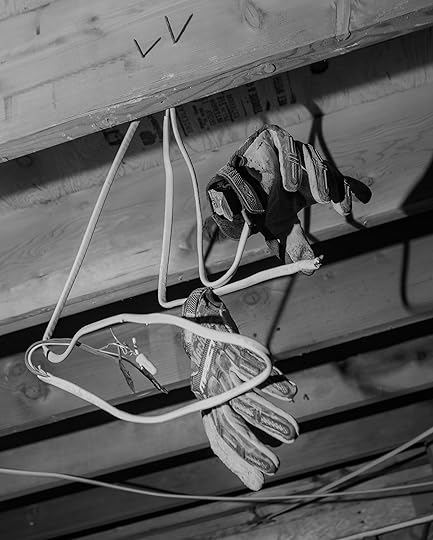 Devin Blaskovich, Untitled, 2022, from the series Don’t Let the Sun Catch You Crying
Devin Blaskovich, Untitled, 2022, from the series Don’t Let the Sun Catch You CryingDevin Blaskovich
In 2021, in his hometown of San Diego, editorial and fashion photographer Devin Blaskovich worked occasionally as a day laborer on construction projects. In time, he began to bring his camera along, photographing the physical objects surrounding him. As he continued the physical work, class consciousness drove creatively to complicate further depictions of building and landscape. “How do you separate it from those symbols that are very mixed with American photographic culture,” he asks, “and still make something that is about human infrastructure?” Though at first glance, the photographs in Blaskovich’s Don’t Let the Sun Catch You Crying appear as a collection of stark black-and-white sculptural still lifes divorced from their material reality, upon closer examination, a second, vastly different visual vocabulary emerges. While a formal reading of the photographs provides enough for an art historian to latch onto, these images are intended for a different audience: working-class viewers, many of whom may recognize Blaskovich’s scenes and the unique labor behind his constructions.
 Kierra D. Branker, Brave New World, 2018, from the series Get It and Come Back
Kierra D. Branker, Brave New World, 2018, from the series Get It and Come BackKierra Branker
In Get It and Come Back, Kierra Branker’s colorful photographs give off a sense of discovery, as if the artist had simply happened upon her subjects. Shades of pink, blue, and brown find common ground across the images, as the scenes of community in south Florida cohere into a narrative of Black Caribbean diaspora (Branker herself is Trinidadian American). In one still life, the thesis is clear: a globe, rotated to show the Americas, with two dark figurines next to it, a set of dominoes in front. The project “has been building more into looking into these objects,” says Branker, “things like carnival headdresses and feathers, music, and dominoes, all of those little details that tell the bigger picture of how we’re moving and passing on legacy from our family members.” Mirrors too recur in the portraits; paired with the domestic settings of other photographs, these works serve to confirm an identity, creating a new home in an unfamiliar place and continuing the memory making of diaspora.
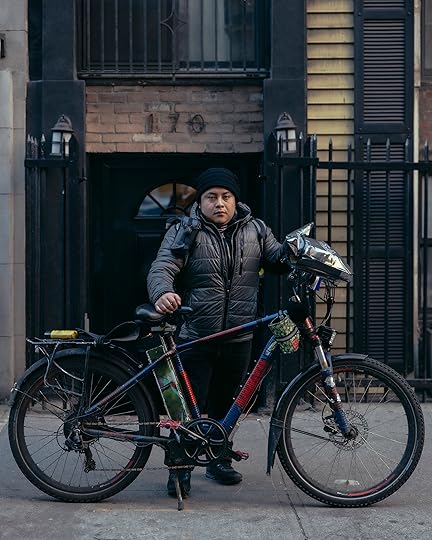 Luis Corzo, Mardo, 2023, from the series Money Transfer
Luis Corzo, Mardo, 2023, from the series Money TransferLuis Corzo
Mixing portraiture, still life, and an indexical sort of architectural photography, Luis Corzo, in his project Money Transfer, follows the homeward path of foreign workers’ remittances to their families abroad. The photographs are clear-sighted and often unsentimental, but Corzo’s diligence brings an emotional touch to an extensive international monetary network. The network itself sometimes plays a role—Corzo describes seeing the storefronts that facilitate remittances in all kinds of settings, first in New York with the delivery workers. “On another occasion, I’m in this little village in the Andes Mountains and Western Union is there,” he says. “I’d like to have an abnormal amount of documentation of these storefronts.” While the individual characters in Money Transfer could get lost in the expanse, Corzo keeps their lives and stories at center stage. By not only focusing on the workers he meets in the United States, Corzo pulls back the curtain on the entire global system, photographing the objects they carry and, eventually, their homes abroad at the other end of the cycle.
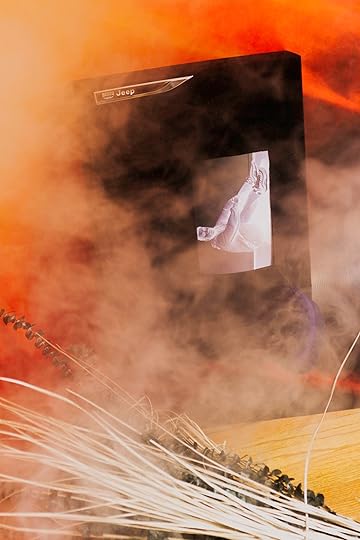 Daniel Diasgranados, Alejandro, 2021, from the series Voyager II
Daniel Diasgranados, Alejandro, 2021, from the series Voyager IIDaniel Diasgranados
For Daniel Diasgranados, suburbia becomes fiction and landscape becomes the universe. Diasgranados spent most of his life in the DMV, the area comprising Washington, DC, and parts of Maryland and Virginia, which he takes as a starting point for his series, Voyager II. “I wanted to make fictional stories through photobooks,” he says, “and really inform them from my life experiences.” The other origin point for the work is the titular NASA spacecraft, launched in 1977 carrying what was known as the “Golden Record,” containing a sampling of sounds from Earth (a greeting from the UN, wind and rain, Mozart and Chuck Berry) as a guide for extraterrestrial life. The settings in Diasgranados’s photographs are hyperlocal—a long stretch of road used for drag racing, a parking lot connected to a space station nearby that first led him to make the Voyager connection—and his collaborators are close friends and siblings. This is his Golden Record: the DMV and its inhabitants take on a universal role, “not necessarily canonizing images, but leaving remnants,” as he puts it.
 Lisa Elmaleh, Hermanas Misioneras de la Eucaristia, 2022, from the series Promised Land
Lisa Elmaleh, Hermanas Misioneras de la Eucaristia, 2022, from the series Promised LandLisa Elmaleh
Around three years ago, Lisa Elmaleh began volunteering with humanitarian aid groups at the US-Mexico border, returning over time to make photographs of the landscape, aid workers, and migrants along the border. Unlike much of the photojournalism documenting the border—often characterized by quick snapshots of action or dramatic newspaper front pages—Elmaleh’s photographs, made with her 8×10 camera, operate with a different approach. “The whole process is slow,” she says. “I get to know each person that I’m photographing. I get to know the landscape in which I’m traveling.” Collectively, the photographs entangle the vast, harsh landscape—where Elmaleh has joined aid groups in search parties for migrants who have gone missing—with the soft portraits of those affected by a history of US policies. The result complicates a narrative often told in short, distinctly presented stories; in lengthening everything from the time spent on a single picture to the long-term goals of her work and activism, Elmaleh tells a story, years in the making, of empathy in a time of migratory crisis.
 Ryan Frigillana, Phantom Limb, 2023, from the series Manong
Ryan Frigillana, Phantom Limb, 2023, from the series ManongRyan Frigillana
In Manong, Ryan Frigillana expertly agitates and bends the archive to navigate a personal and collective history of Filipino migrants in the United States, centered on his family. “Combing through visual history is my attempt to exhume those hidden parts of myself, the parts that live in my body but can’t be seen,” he says. The photographs are presented in physical entanglement, with archival images placed within and on top of Frigillana’s own photographs, or vice versa. Past and present are one and the same, acknowledging history, as he explains, “not as an inert relic, but as a living, breathing, and speaking presence.” Frigillana primarily focuses on his parents, and his closeness to this collective history is apparent in his portraits of his mother and the material details of their life in America. In total, Manong provides a formally distinct addition to photography’s ability to tell an asynchronous history of oneself and one’s community.
 Golden, I am home in the arms of the armed, 2022, Isabella Stewart Gardner Museum/Dutch Room, from the series On Learning How to Live
Golden, I am home in the arms of the armed, 2022, Isabella Stewart Gardner Museum/Dutch Room, from the series On Learning How to LiveGolden
“My photographs center Black queer autonomy,” says Golden, whose series On Learning How to Live navigates the lives of the photographer and their close community in strongly lit environmental self-portraits. Almost painterly in construction, Golden’s photographs are painstakingly detailed, often planned out days or weeks ahead of the camera’s entrance. Golden often takes center stage themself—occasionally surrounded or embraced by others—in domestic scenes with varied living standards. In one tableau, Golden stands perched on a chair in front of a wooden fence; in another, between red armchairs in a lavishly decorated room. Even so, the subjects are presented with dignity. “I remember studying European paintings in art history during undergrad, and usually, only white figures were staged confidently and propped up within and surrounding the home,” they say. “In my images, the kitchen chairs, broken backyard fence, bedroom ottomans, and mattresses become the thrones, the pulpit, the homes, and the nation.”
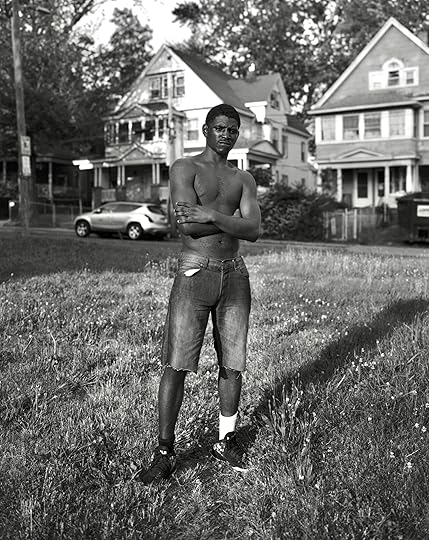 Jeremy Grier, Mr. Bell-Lovett, 2021, from the series Hartford North End
Jeremy Grier, Mr. Bell-Lovett, 2021, from the series Hartford North EndJeremy Grier
“The lack of documentation of Black life up north in New England is something that is very real,” says Jeremy Grier. During the pandemic, Grier moved back to his hometown of Hartford, Connecticut, and over time he began to reexamine the once familiar city, making environmental portraits of its residents in the places he knew. The lineage of Black portraiture—from James Van Der Zee to Roy DeCarava to Dawoud Bey—has a metropolitan history, and while that history resonates with Grier’s photographs, these images are also informed by the photographer’s own relationship to Hartford. In backgrounds, familiar viewers will recognize Albany Avenue, or Sigourney Square Park, where a young group poses playfully, engaged with Grier and his 4×5 camera. Beyond the photographs’ reference to the history of the medium, Hartford North End, as Grier titles this project, is an ode to a Black community full of life in the Northeast.
 Avijit Halder, birth, 2019, from the series नेति नेति (Not This, Not That)
Avijit Halder, birth, 2019, from the series नेति नेति (Not This, Not That)Avijit Halder
After their mother’s death, Avijit Halder inherited a collection of saris. For more than a decade, they kept them, migrating in that time from Kolkata to the United States. In a way, the saris existed more as a material archive than a wardrobe. After years of storing them away, Halder began to use the saris in photographs, wearing and waving them, activating the objects to create colorful scenes full of motion. “I was interested in this symbol of ultimate femininity in our culture,” they say, “and how that plays with this idea of gender and body that I was exploring.” Their collaborators in the photographs were members of their queer community in Brooklyn, where Halder lived while completing their MFA at ICP-Bard, and a level of intimacy emerges from each image. Stable, somber self-portraits of Halder contrast the ecstatic photographs of others modeling the saris, hinting further at Halder’s close personal connections to the people and objects across the series. The resulting project, नेति नेति (Not This, Not That), takes the saris as a starting point to look at the expansive fluidity of gender, culture, and material inheritance.
 Oji Haynes, Happy Family, 2022, from the series Drylongso
Oji Haynes, Happy Family, 2022, from the series DrylongsoOji Haynes
Oji Haynes thinks about his photographs as poems, giving himself space to reflect before making the work, referring to an image as an artifact and a fable. “The medium itself runs deep just like the history of Black life,” he says. “They honestly go side by side.” Likewise, the photographs join together like lines of verse. A scene of young men wearing black hoodies seated in a restaurant is followed by a collage of gray sweatsuits: incarcerated men in found photographs purchased on eBay. Later, new men in gray appear, glancing back as if the camera were an unexpected visitor. The portraits are intimate—a woman sitting on a bed, her red dress contrasting with the white sheets; a woman embracing a man from behind in a dimly lit bedroom—and add depth to the documentation of Black life as a shared history. Haynes describes his process as instinctual: “It really comes from just sitting still and listening most of the time.”
 Jenica Heintzelman, Four Hands, 2020, from the series Down a Stream
Jenica Heintzelman, Four Hands, 2020, from the series Down a StreamJenica Heintzelman
In Down a Stream, Jenica Heintzelman engages medical and therapeutic skepticism with a critical, yet open mind. After a doctor suggested that unresolved trauma could impact her health, she began to research mind-body therapy and similar alternative healing practices. “I grew up with this idea that if you have faith, you will be healed,” says Heintzelman, who was raised Mormon and has since left the church. Rather than using a documentary photographic approach, Heintzelman works with actors and dancers to recreate and improvise scenes referencing the group therapy sessions. “A lot of what I was trying to portray,” she says, “was the subconscious part of healing, the darker side.” The photographs are almost claustrophobic; harshly lit, they closely focus on faces or hands, a “catalog of gestures,” as Heintzelman calls it. A few do not feature people, instead exploring the spaces around them, similarly uninviting—closed doors, the backs of picture frames, furniture pushed close together.
 Natalie Keyssar, Untitled (Sofia from Luhansk), 2022, from the series Ukranian Love Letter
Natalie Keyssar, Untitled (Sofia from Luhansk), 2022, from the series Ukranian Love LetterNatalie Keyssar
Natalie Keyssar began to cover the war in Ukraine as a photojournalist soon after Russia’s invasion in February 2022. Since then, she has photographed on assignment for Time magazine, the New York Times, NPR, and other outlets. In Ukrainian Love Letter, Keyssar reorganizes her commissioned documentary work alongside unpublished images from her ongoing time in Ukraine, producing a heartfelt narrative of a nation in crisis. Keyssar presents many of her photographs as diptychs, taking the opportunity to collapse time and “rearrange the emotional and sequential landscape” as she says. The title of the series refers first to the relationships between Ukrainians of all backgrounds, but also to the photographer’s own love letter to the country and those she’s met. “I feel like weaving these things together is how I’ve always done my work,” Keyssar says. “It’s how I’ve figured out how to be an artist and a journalist at the same time, and reconcile that in a way that feels true and honoring to the people in the photographs.”
 Ryan Patrick Krueger, For My People (Semiotics #1), 2022, from the series On Longing. Photograph by Kalaija Mallery
Ryan Patrick Krueger, For My People (Semiotics #1), 2022, from the series On Longing. Photograph by Kalaija MalleryRyan Patrick Krueger
Ryan Patrick Krueger has been collecting photographs since he was a teenager living in Portland, Oregon. Initially combing through antique stores in the city, he eventually moved online, to sites like eBay, simply searching “gay interest” to uncover archives from the pre–Gay Liberation era of the 1960s. On Longing, first exhibited in 2022 at Monaco Gallery in St. Louis, presents a wide-ranging collection of these photographs in a scientifically detailed, curatorially organized, and ambitiously displayed set of collages. “I use the exhibition space to create a temporary memorial with these materials,” Krueger says. Layers of found photographs find new meaning among pictures photocopied from pre-Stonewall yearbooks and excerpts of Hal Fischer’s Gay Semiotics. Krueger does not shy away from the painstaking work involved in uncovering these images, often including mailing envelopes from eBay sellers and, as byproduct, every address he has held for the last decade. “I long to understand that history of invisibility,” he says, “where I can situate myself in a history and culture that I am proud of.”
 Xi Li, Deep Emotions (Tulips), 2022, from the series Surface Memory
Xi Li, Deep Emotions (Tulips), 2022, from the series Surface MemoryXi Li
In Xi Li’s photographs, scenes staged in a studio become abstracted beyond easy recognition. Li constructs objects, projects, and images; repurposes materials; and, eventually, photographs her creations. She refers often to the role of memory, both personal and collective, in shaping her work, Surface Memory. “I believe that memory is a choice,” Li says. Whether the choice is in our own perception of memory, or in the act of remembering at all, the questions Surface Memory raises come with no simple answers. The work also navigates the fallibility of her own memory. Li left her home in China ten years ago, and she uses the photographic process to rebuild a concept of home. “I consider the unstable harmony between actual and fictive recollections,” she says, “and want to blur the lines in between.” In one diptych, Li photographs a still life of real plants—migrant plants from Asia, she says—potted alongside photographs of plants printed from public domain images. This is perhaps her most straightforward image: the signified and signifier in union.
 Ira Lupu, Zvoir, from the series Time of the Pheonix
Ira Lupu, Zvoir, from the series Time of the PheonixIra Lupu
“Back then it still felt terribly dangerous,” says Ira Lupu, from her family’s home in Odesa, about her first return to Ukraine in April 2022, a few months after Russia’s invasion. “It still is, but you learn to navigate that.” This line of thinking seems to characterize the familiar clichés of war photography from Ukraine, in newspapers and online, with the dominant early coverage tapering off into only occasional snapshots. Since that initial visit, Lupu has gone back and forth between New York and Odesa, making a collection of photographs titled Time of the Phoenix that embraces an empathetic view of her home country and its people. Though traces of the war remain in the photographs, a human focus pervades. “I’ve been focusing on the things that are not as visual and do not fall into this photographic vocabulary of the war,” Lupu says. Some of the scenes require context if seen individually—the young people on a mountain in one image, for example, are refugees, soldiers, and combat medics—but the conflicted reality of life amid war reveals itself as a method of survival in Lupu’s photographs.
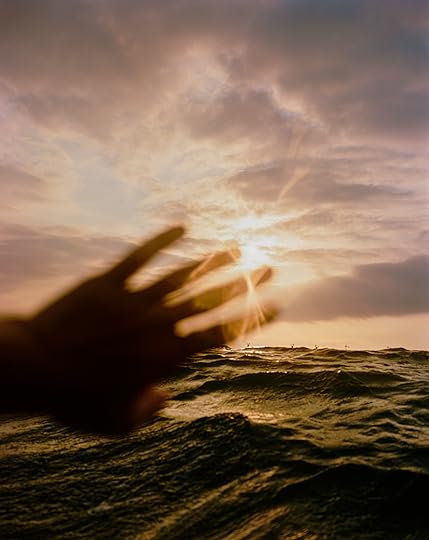 Yael Malka, Untitled (Last Goodbye), 2022, from the series The People’s Beach
Yael Malka, Untitled (Last Goodbye), 2022, from the series The People’s BeachYael Malka
Yael Malka’s The People’s Beach began as a commission from the New York Times, a three-month-long assignment to cover the last summer before the People’s Beach at Riis Park—a haven since the 1940s for New York’s queer community—would be closed for the demolition of a nearby building. A New Yorker and a queer photographer, Malka was a fit for the project, and the resulting photos show a deep care for the community that frequents the beach. Malka made the work entirely on film, including additional Super 8 video footage. The resulting warm, sunbaked photographs feature portraits of beach regulars, landscapes showing a divine sunset over the beach, and details such as flowers lining a fence, or a hand blocking the waning sun’s glare against the water. The personal project extends beyond the work published in the Times, adopting a more nuanced and historical perspective. “My point of view is in the photos,” says Malka. “Things that point to a tension or some sort of violence.” The work continues; Malka has returned to document the demolition, and further, the revival of the People’s Beach.
 Ashley Markle, Divers, 2023, from the series The Lion and the Lamb
Ashley Markle, Divers, 2023, from the series The Lion and the LambAshley Markle
“A big part of my work is looking at the individual,” says Ashley Markle, “and seeing how the individual forms the collective.” This balance is at the center of the photographer’s series The Lion and the Lamb, in which she embeds herself with the Columbia University wrestling team. She chose wrestling for its structure as a distinctly individual sport—endless hours of preparation for a single seven-minute match, one competitor versus another—but one that’s nonetheless played as a team. Markle focuses on the movement of the wrestlers’ bodies, recalling her interest in dance and positing wrestling as its hypermasculine surrogate. Her photographs engage the athletes closely, following the ritual of practices and matches with an anthropological sensitivity. In many of the photographs, the young men grasp and grapple intimately in the frame of Markle’s camera. She also makes space for collaboration, photographing a set of portraits of wrestlers standing in front of a red backdrop held up by their peers. The collaboration between teammates is part of the process, Markle explains. “Their moment will come too.”
 Ashley McLean, Femi in the Glade, 2021, from the series Seeking you in other bodies
Ashley McLean, Femi in the Glade, 2021, from the series Seeking you in other bodiesAshley McLean
In her tender portraits of young Black fathers, Ashley McLean opens a conversation about the dominant representations of masculinity, fatherhood, race, and domesticity. As a response to negative media portrayals of Black men, McLean began making photographs she describes as calm, less abrasive than traditional protest art. “I want the men in my community to see themselves as pure and tender through these images,” she says, reflecting on how the men she knows have been raised alongside those portrayals. “I see myself as this mediator between the world and how these men present themselves.” In one photograph, a father holds his child next to a Romanesque statue of a man, a distilled vision of the project’s thesis of expectation and reality. Going beyond an approach that holds the work in the polemic realm, McLean makes these photographs for the people in them. “I’m leaving behind these images for these young kids and their parents,” she says, “creating a beautiful memory that they can have in their albums.”
 Arlene Mejorado, Mother Standing in a Pool Re-embodies One of Her Childhood Photographs from Mexico, 2023, from the series A Landscape Holds You Still
Arlene Mejorado, Mother Standing in a Pool Re-embodies One of Her Childhood Photographs from Mexico, 2023, from the series A Landscape Holds You StillArlene Mejorado
A Landscape Holds You Still, Arlene Mejorado’s series of photographs rooted in Los Angeles’s San Fernando Valley, brings together portraits of the artist’s family and scenes deconstructing an outside perspective of the region. Beyond the community living there, the valley is home to major film studios and cultural depictions—in many ways, the landscape operates as a stand-in for anywhere. By acknowledging the way this place has been seen both by her and by others, Mejorado breaks down the way one can create a construct of home. “I was thinking about how communities can write ourselves into a landscape that we are living in, through memories and archives,” she says. Mejorado photographs family members in street medians, using a banal but liminal space for environmental portraits that force viewers to take in the surrounding landscape. Another image recalls Cindy Sherman’s Untitled Film Stills (1977–80); the low-angle portrait recontextualizes the film industry’s cityscape for Mejorado’s community story, as if to say, “We belong here.”
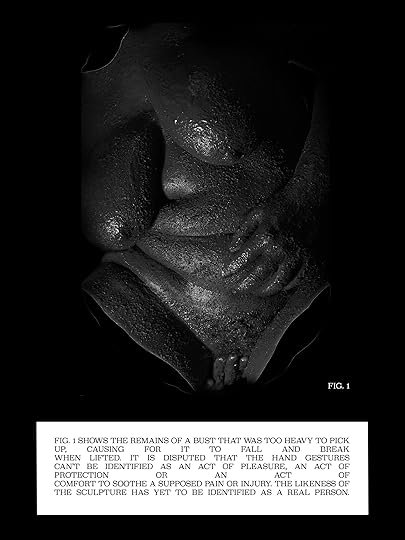 Shala Miller, Likeness Unidentified, 2022
Shala Miller, Likeness Unidentified, 2022Shala Miller
Shala Miller embodies every role in Obsidian, an expansive multimedia project combining fiction, autoethnography, and self-portraiture with superhero comic books and a distinctly Black femme perspective. The concept came to Miller as a healing response to several instances of abuse, a way to reclaim power and harness some of the rage she was feeling. In Obsidian, Miller is not only the titular character—hero or villain—but also the historian researching the character and the original author. “It started from a very specific personal experience of being abused by these people in my life,” she says, “and then it’s as if the rage has a reverberation to it … you can see it beginning from me and then growing to reach the collective masses.” The individual images each contain layers of narrative context, whether from Miller’s iconic poses (as Obsidian) or the handwritten text and photo-objects placed around the portraits. Viewed as a complete set, the project leans into its contradictions and questions the nature of photography and storytelling.
 Clara Shuku Mokri, from the series آلبالو پلو (Cherry Rice)
Clara Shuku Mokri, from the series آلبالو پلو (Cherry Rice)Clara Shuku Mokri
Bright reds and blues leap from the images in پلو آلبالو (Cherry Rice), a family narrative from Clara Mokri focusing on her Iranian cultural heritage from her father’s side of the family. “It’s all a way to connect,” she says. “My parents don’t share a culture, so it was really about getting to experience both cultures intimately from my perspective.” Mokri’s work as an editorial photographer has established the pop of color as a familiar trait, but here it is imbued with a renewed significance in sharing her family’s story. Details such as a Coca-Cola can, brilliantly red over a tray of food, or a man’s denim, a light blue set against a field of wheat, become central points of cultural awareness as Mokri emphasizes the objects and icons that characterized assimilation for her father and his sister, who came to the United States in the late 1970s, during the Iranian Revolution.
 Colton Rothwell, Dependency, 2023, from the series Elegy
Colton Rothwell, Dependency, 2023, from the series ElegyColton Rothwell
The American Mountain West finds itself under critical inspection in the photographs of Colton Rothwell. Elegy, a roaming collection of black-and-white images made across Idaho, where Rothwell was raised, and Montana, where he now lives, evokes the history of photography’s manifest destiny and New Topographics—particularly the photographs of Robert Adams—reinvigorated with a haunted and distanced unfamiliarity. Taking his queer identity as a starting point, Rothwell faces the mythology of the West and its imposed masculinity head-on, often through depictions of charged memories: a standalone cross in a field, the interior of a car, two shirtless men, a shared cigarette. “It’s often not what you’d expect to see,” he says, “queer people in the Western landscape and thriving.” The topography becomes animated as a character, its harshness acknowledged and summarily disarmed. As the viewer sits with the photographs, Rothwell’s vision of an imaginative West takes hold: an expansive landscape full of possibility.
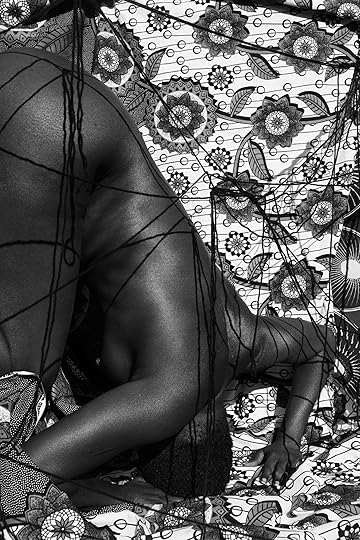 Keisha Scarville, Negotiating/Maneuver (18), from the series Li/mb
Keisha Scarville, Negotiating/Maneuver (18), from the series Li/mbKeisha Scarville
Keisha Scarville started photographing her family while visiting her home in Guyana during the early stages of the COVID-19 pandemic. “I started to think about what it means to move between two different spaces, the struggle to find connection in those different spaces,” she says. Scarville’s interest in family units, traveling back and forth between Brooklyn and Guyana, eventually turned into an interest in the traditional Caribbean limbo dance, and the way Black bodies maneuver through space. “There’s this level of absurdity but also amazingness about the limbo,” she says. “This idea of success being predicated on how you can move through constraints.” In her series Li/mb, Scarville reconstructs the limbo in expertly staged self-portraits (though a few feature her cousin as a stand-in). The photographer poses on textiles, adding further layers to the complexity of cultural identity and spatial reality. Body and background merge together, offering an introspective look into the threshold between self and community.
 Tam Stockton, Untitled, 2022, from the series Sometimes I Think of What’s Forgotten
Tam Stockton, Untitled, 2022, from the series Sometimes I Think of What’s ForgottenTam Stockton
“I tend to be attracted to pictures that sit on the edge of being a joke,” says Tam Stockton, whose series Sometimes I Think of What’s Forgotten finds itself on the edge of several lines—between photography and sculpture, digital and analog, reality and fiction. Stockton constructs his images in various ways that go beyond traditional photographic means; in several instances, he prints, cuts, rearranges, and rephotographs existing images into new constructions. The results are uncanny, surreal imprints of recognizable features of life that Stockton describes as almost nostalgic. Reconstructed collages of nature and domestic life—the cloudy blue sky above a field, a man sitting on a rooftop—lead to recollections of something almost there but just out of reach, the familiar feeling of a memory rather than the fact itself. Stockton is hesitant to define any firm meaning in the work. “I try to separate out the images that I feel hold this confusion, or that have the potential to,” he says. The photographs highlight the malleability and playfulness of memory, letting the viewer in on the joke.
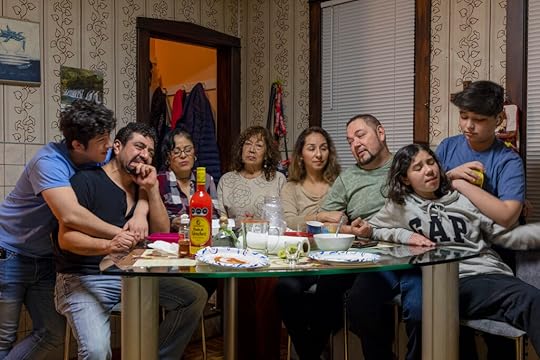 Jennifer Teresa Villanueva, Reunidos para Año Nuevo durante COVID, 2021, from the series ¿Quieres Salvar Al Mundo? Empieza por tu Familia
Jennifer Teresa Villanueva, Reunidos para Año Nuevo durante COVID, 2021, from the series ¿Quieres Salvar Al Mundo? Empieza por tu FamiliaJennifer Teresa Villanueva
Jennifer Villanueva, in ¿Quieres Salvar Al Mundo? Empieza por tu Familia (Do You Want to Save the World? Start with Your Family), explores the complex dynamic of an immigrant family through the objects and routines of their daily life. As a student, Villanueva began documenting her mother and grandmother, who immigrated from Mexico, but the project took a turn during the process of helping her parents attempt to obtain legal resident paperwork. The photographs do not shy away from the struggles and sacrifices across generations, but they retain a sense of resilience. One image, a sort of categorical still life taking stock of Villanueva’s grandmother’s items, appears to be constructed by the photographer; in fact, the objects were laid out already. “I’m not just trying to reveal her identity and submit that to the public,” says Villanueva. “I want this relationship between the domestic and the public, this idea of being legal and illegal.” As a whole, the series is both organizational and aspirational, a project of legibility in the face of overwhelming political obstacles.
 Ramona Wang, Meiting and her room, 2023, from the series My friends are cyborgs, but that’s okay
Ramona Wang, Meiting and her room, 2023, from the series My friends are cyborgs, but that’s okayRamona Jingru Wang
Don’t let the playfulness of the title of Ramona Wang’s series—My friends are cyborgs, but that’s okay—belie the sophistication of its goals. Discussing her practice, Wang references academic theorists from Edward Said to Donna Haraway, combining their work to form a concept of “Techno-Orientalism,” a fusion of fluid, outsider identities seen as the Other. Wang, who was born in Guangzhou, China, and now resides in New York, primarily focuses the project on Asian identity, emphasizing the expectations and marginalization faced by her collaborators for simply existing in a world that dehumanizes their bodies. “I would tell them this is a mockumentary,” she says. “You have to imagine that you are a cyborg, and it’s a documentary of you.” The careful poses in the portraits are often at odds with their domestic environments, as Wang’s mockumentary subjects continue to play a role even within the privacy their own homes. But her photography is also an act of care and solidarity. “I think I am part of them in this imaginary cyborg community,” she says.
 Isaiah Winters, Blackfeet Catholic School, 2019 from the series This Land Is Your Land
Isaiah Winters, Blackfeet Catholic School, 2019 from the series This Land Is Your LandIsaiah Winters
After his military service as a linguist and analyst in the US Air Force, Isaiah Winters took some time off to visit the national parks of the American West. The discomfort he experienced as a Black man encountering the idealized symbolism of manifest destiny led Winters to investigate the visual culture that surrounds the park system. His series This Land Is Your Land brings together mixed media collages of collected visual objects from advertising to found archives, as well as photographs made by Winters of the people he has encountered in the parks over the past couple of years, primarily in Glacier National Park and Yellowstone. Winters says he has a storage unit full of “everything Western memorabilia,” and his collection spans well beyond what has been used so far. “As I started to dig more and more, I had a much more critical approach to it,” he says. “It’s impossible for me to see these parks the same way anymore.”
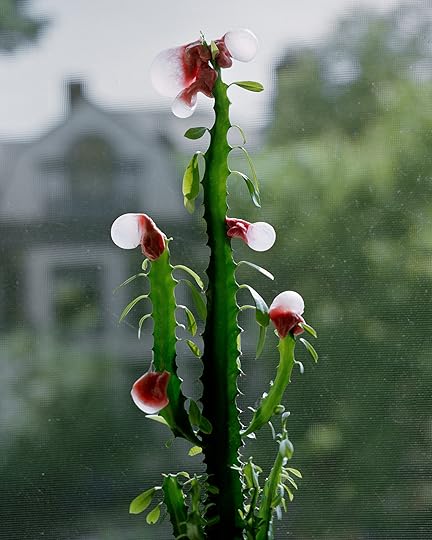 Zhidong Zhang, Cactus, 2022, from the series No Place Like Home
Zhidong Zhang, Cactus, 2022, from the series No Place Like HomeZhidong Zhang
Zhidong Zhang’s photographs are works of collaboration. Their series No Place Like Home confronts the diaspora experience (Zhang was born in Hunan, China) in portraits of their close friends and family members mixed with still lifes of the objects they have carried for years. When discussing the project, Zhang recalls a concept from the filmmaker Trinh T. Minh-ha of “speaking nearby” rather than “speaking about,” a way to leave open space for representation. “I’m trying to move my way of making images,” says Zhang, “speaking nearby my queerness, my diasporic experiences, and the condition of in-betweenness that has inhabited my body over the years.” Zhang finds space for themself and their collaborators to exist between the reality of diaspora and the expectations placed upon them, “Metabolizing bodies that are often politicized and eroticized in very exploitative ways,” as they say. Through their quiet constructions, the photographs look back on Zhang’s personal history and invite an alternative future.
Artist statements by Eli Cohen.
September 21, 2023
Zohra Opoku’s Evocative Reflections on Mortality and Resilience
The German Ghanaian artist Zohra Opoku first visited Ghana in 2003, having grown up in East Germany. In 2011, she relocated to Accra, where the emotional and aesthetic inspiration she finds in the city has become a prevailing element in her art. As Opoku says, “Once you are in Ghana, Ghana becomes you and you become Ghana.”
Through a practice centered on textiles and photography, Opoku explores nuanced themes of cultural identity. She prints directly onto textiles, weaving together archival images, family photographs, and self-portraiture to create lyrical composites that marry personal experience and collective memory.
In 2019, Opoku received a diagnosis of breast cancer. She began her most recent body of work while receiving treatment in Berlin and continued its development during an artist residency in Dakar, Senegal, at Kehinde Wiley’s Black Rock Senegal program. The resulting series, The Myths of Eternal Life (2020–22), takes its structure and inspiration from the Egyptian Book of the Dead, an ancient text that provides instruction on preparation for the afterlife. Opoku’s art offers lyrical reflections on questions of mortality and resilience she found herself addressing during and after her illness.
 Zohra Opoku, In Bob’s Footsteps, 2017. Screenprint on cotton, tea dye, denim, thread
Zohra Opoku, In Bob’s Footsteps, 2017. Screenprint on cotton, tea dye, denim, thread 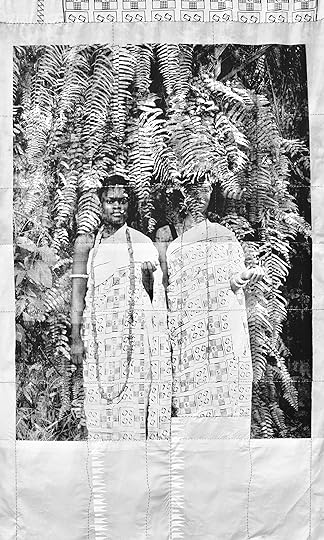 Zohra Opoku, Debie, 2017. Screenprint on canvas and cotton, black tea dye, thread, acrylic
Zohra Opoku, Debie, 2017. Screenprint on canvas and cotton, black tea dye, thread, acrylic Ekow Eshun: Let’s start at the beginning, with you growing up in East Germany. In what ways does that play a part in the work you do today?
Zohra Opoku: The GDR (German Democratic Republic) is now just a subject in school, it’s part of history, something children have been taught. Childhood was amazing, but looking back, I understand how, for my mom, it was an upsetting story, while for my dad it was a devastating story. My father did his PhD in economics in the GDR, and after he had to return to Ghana I was born in Germany. He could write us, come back, try to connect. But then, also, it was a time of no internet and not having phones in the home. When he started studying abroad, it was part of the exchange program developing in East Germany, because for the GDR, Ghana was kind of a neutral country.
Eshun: Part of the socialist states reaching out to the so-called third world at that time.
Opoku: Right. My parents tried to stay connected with letters. My dad could have taken me to Ghana, but not my mom. That was the really sad part. I grew up with a stepdad, and then a single mom, because she and my stepdad got divorced. It was an environment of Caucasian people around me. I tried to explain to myself why I looked different. I made up stories. I was very young, around five. I told my friends that there was something wrong with my baby milk.
Later, when the wall came down and I was able to travel to West Germany, my auntie, who was kind of my mentor, started traveling with me. She took me to London, and it was so liberating because finally nobody stared at me. I felt like I could just disappear. I think that’s where I started to realize that what was missing for me in my upbringing was a connection to my African background. It is always the driving force, this question of identity. How can I relate to the place I’m dealing with? How do I connect? What is familiar? And what do I have to bring to reconnect to the new environment? That’s how my self-portraits actually came out, because it was always a question: What is myself here?
 Aperture Magazine Subscription 0.00 Get a full year of Aperture—and save 25% off the cover price. Your subscription will begin with the summer 2023 issue, “Being & Becoming: Asian in America.”
[image error]
[image error]
Aperture Magazine Subscription 0.00 Get a full year of Aperture—and save 25% off the cover price. Your subscription will begin with the summer 2023 issue, “Being & Becoming: Asian in America.”
[image error]
[image error] 
In stock
Aperture Magazine Subscription $ 0.00 –1+ View cart DescriptionSubscribe now and get the collectible print edition and the digital edition four times a year, plus unlimited access to Aperture’s online archive.
Eshun: You studied fashion in Hamburg. But with the materials you use, there is a merging of vintage fabrics, photography, and imagery as a way to explore large questions of history and memory, of place and identity. How did you come to this as a way of working?
Opoku: Today, it looks like such an organic process. When I grew up, my mom was always sitting at the sewing machine or knitting; my grandmother was doing embroidery and knitting as well. The handcraft was present in my upbringing. And painting and drawing came naturally to me. Textiles were always around. Later, when I studied fashion, I realized I was already done with it; I spent more time in the photo department than in the fashion department. I was exploring black-and-white photography, especially because it always connected me to my childhood, because all the archival photographs of my mom and my grandparents, and the pictures in our photo-albums, everything that I found was black and white. Even later, when color photography became a modern thing, it was still cheaper to do it in black and white.
Eshun: When did drawing and painting become part of the process?
Opoku: Drawing and painting were always part of it. But I would never actually see myself as an artist. I’ve always thought, I’m a fashion designer. I’m going to be big in fashion. I kept going for many years, doing styling, working for fashion brands, doing window installation, working in design, traveling in Europe, living in Copenhagen and Paris. But I always felt like my soul couldn’t expand; it couldn’t really explore and understand a lot of things. I realized that with fashion, it’s so fast, and too beautiful to seek the truth. As an artist, you always want to excavate the truth of something.
I feel like the body is just existing in a particular time of the life span, but our soul, our being, is continuing.
Eshun: How long have you lived in Ghana now?
Opoku: For twelve years.
Eshun: Why did you move to Accra?
Opoku: It has the energy I was seeking. Since 2003, I came to Ghana maybe every other year. Every time I returned to Germany and arrived at the airport, I felt so empty—something was missing. I just knew I had to find a way to turn it around and visit Germany from time to time.
Eshun: There’s so much emphasis in your art on embroidery and weaving and a handmade sensibility. It seems to me it makes everything very personal—that there’s you in the fabric of all the work.
Opoku: I think the textiles were coming back to me strongly when I started living in Ghana. Everything is textile for me in Ghana. It has so many meanings, histories, and backgrounds that I wouldn’t really feel or be able to touch on in Germany—or understand. Even if I would want to dive into the same topics I’m touching on in Ghana, it’s just not the same energy. It’s like once you are in Ghana, Ghana becomes you and you become Ghana. I was also able to articulate my family heritage, my emotions within my identity, using Ghanaian symbolism and traditions.
And I insist now, when we are describing the works, that people actually understand that everything is handmade. I don’t want to have any machines involved. Today, everything is ultradigital. I wanted to stay within that kind of analog space, similar to how I grew up.

Zohra Opoku, “I have opened the doors of truth. I have passed the waters of heaven. I have raised up a ladder to heaven among the gods. I am one who is with you,” 2023. Screenprint on dyed vintage linen with embroidery
var container = ''; jQuery('#fl-main-content').find('.fl-row').each(function () { if (jQuery(this).find('.gutenberg-full-width-image-container').length) { container = jQuery(this); } }); if (container.length) { const fullWidthImageContainer = jQuery('.gutenberg-full-width-image-container'); const fullWidthImage = jQuery('.gutenberg-full-width-image img'); const watchFullWidthImage = _.throttle(function() { const containerWidth = Math.abs(jQuery(container).css('width').replace('px', '')); const containerPaddingLeft = Math.abs(jQuery(container).css('padding-left').replace('px', '')); const bodyWidth = Math.abs(jQuery('body').css('width').replace('px', '')); const marginLeft = ((bodyWidth - containerWidth) / 2) + containerPaddingLeft; jQuery(fullWidthImageContainer).css('position', 'relative'); jQuery(fullWidthImageContainer).css('marginLeft', -marginLeft + 'px'); jQuery(fullWidthImageContainer).css('width', bodyWidth + 'px'); jQuery(fullWidthImage).css('width', bodyWidth + 'px'); }, 100); jQuery(window).on('load resize', function() { watchFullWidthImage(); }); const observer = new MutationObserver(function(mutationsList, observer) { for(var mutation of mutationsList) { if (mutation.type == 'childList') { watchFullWidthImage();//necessary because images dont load all at once } } }); const observerConfig = { childList: true, subtree: true }; observer.observe(document, observerConfig); }Eshun: You’ve talked before about having an affinity with West African studio photographers such as Malick Sidibé and Seydou Keïta—the ways they used fabric as backdrops but also as part of the self-fashioning of their subjects.
Opoku: Absolutely. I have all the books of these masters. In the very beginning, I was even more interested in photographing or portraying other artists or other people, and I used their clothes as a sort of tool to drape around the body, to actually capture an energy. It’s like taking your time and carefully thinking through the process: What does the material say? What does the print say? How does it look in black and white, for instance? Because photographing in color or black and white are two different thought processes. This kind of style, expressing swag, expressing a kind of African soul, being in that space of coolness—that’s something I was seeking.
Eshun: With the family photographs and family fabrics, do you consider these an archive that you’re drawing from?
Opoku: I started to really appreciate this idea of an archive when my dad passed, because he was also a traditional leader. When I created the series, I was working with the old photographs and the textiles from my father. They don’t only give you a material thing—so many memories are burned into that fabric. I realized how heavy the fabrics are, how difficult they are to handle and actually wear, and how my father could walk in them and move in them the whole day. It’s not just a piece of fabric or a cloth. You have to be able to carry them, especially these old, traditional kente; when they are made from silk, they are much heavier than the new ones. In Ghana, a lot of things are not archived, and so, for me, it’s very important to make sure we preserve and take care of them.
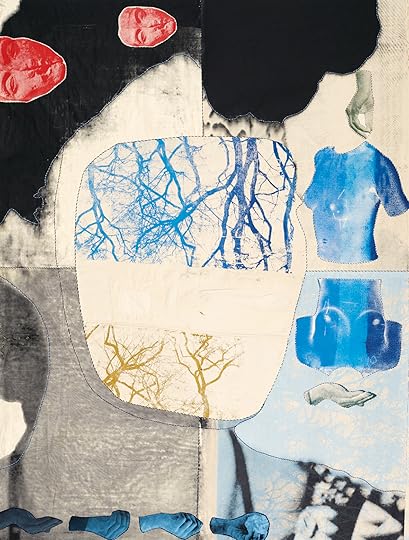 Zohra Opoku, “I have arisen from my egg which is in the lands of the secrets . . .,” 2020. Screenprint on linen
Zohra Opoku, “I have arisen from my egg which is in the lands of the secrets . . .,” 2020. Screenprint on linen 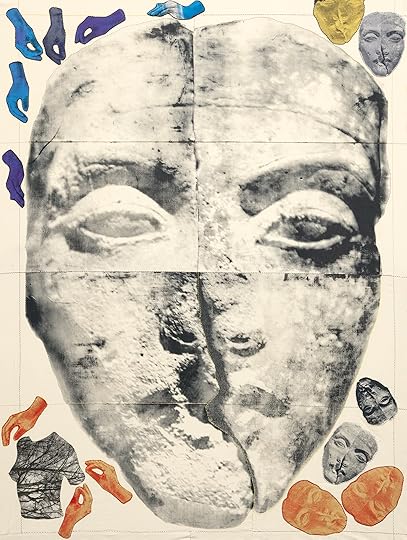 Zohra Opoku, “My head shall not be taken from me. You shall raise me up. You shall make me new. You shall rejuvenate me,” 2023. Screenprint on vintage cotton with embroidery
Zohra Opoku, “My head shall not be taken from me. You shall raise me up. You shall make me new. You shall rejuvenate me,” 2023. Screenprint on vintage cotton with embroidery Eshun: In your series Self Portraits (2016–ongoing), you are there but not there. Your face is obscured by foliage. What are you exploring in those works?
Opoku: I explore a version of the self, right? I want to look into a social environment, geographical environment, a dialogue with a surrounding. I was at an artist residency in Berkeley at the Kala Institute, and I ended up having more conversations with the landscapes around there, and looking at myself. I was very intrigued by the fact that most of the plants are actually not from that area. They were immigrants, like me. Plants from Middle Europe to the Mediterranean to desert to grassland. There’s this wide range. It was impressive to me how everything could grow in California. And since I have a very strong background of farming and being in nature—my father was also very strongly connected to greenery—nature really represents home to me.
Eshun: In 2019, you were diagnosed with breast cancer, which must have been very difficult. When you started making work in relation to that, you looked to the Egyptian Book of the Dead. What did you find in that book?
Opoku: In the beginning, I was just trying to figure out how to survive, how to get through all these treatments. I ended up in Berlin. I had a bicycle and would ride through parks and go to museums, where I fell in love with ancient Egyptian mythology. That’s how I decided to work with the tomb paintings, the colors, the hieroglyphs. To understand their meanings and the concept of afterlife—and that I can create my own narrative around this.
Eshun: Let’s talk about those trees, because they are present throughout the series The Myths of Eternal Life. You started photographing these trees while you were receiving treatment. They’re in a park in Berlin, but all the trees are bare because it’s winter. They’re yet to blossom and produce new life.
Opoku: What I found interesting is how trees are a metaphor for life and death. I thought, Okay, they can become my protagonist, something that reappears in all the works. By my printing them in so many colors, they morphed into things we can feel or imagine, like veins, or streams of rivers, or greenery, or a kind of energy.
Advertisement
googletag.cmd.push(function () {
googletag.display('div-gpt-ad-1343857479665-0');
});
Eshun: They are another form of self-portrait, in a way. We see you with nature again, but it’s a different form of nature now, compared to the Self Portraits series. It’s empty branches and so on. But also, your body is dismembered, as it were, in separate pieces—your head, your arms, your legs. How much is this speaking of your mental state or your physical state at that time?
Opoku: I feel like the body is just existing in a particular time of the life span, but our soul, our being, is continuing. What represents that? And, on the other hand, I found it interesting how hieroglyphs have elements of body parts as a sign language. Now, my pieces are becoming more complex, because I print and cut and apply, then I have the embroidery, and then I have all kinds of practical stitching. There are so many different layers that create the narrative.
Eshun: Did you have in your mind an aesthetic goal for these pieces?
Opoku: The first night after I had the diagnosis, I started dreaming. I never wrote the dreams down but they were present in my thoughts. I realized that something in my work has to reflect that very surreal feeling.
Eshun: What kind of dreams were they?
Opoku: I was dreaming of dying. Dreaming of being buried. Very weird constellations of people around me, who don’t know each other, talking to me about my decisions. Because I decided against the chemotherapy and against hormone therapy. With this, I took a risk but wanted to engage in holistic healing. It’s hard to actually put in pictures. But what I always saw was the sun. That was also something that I always missed in Berlin. That’s why I chose the sun god Re in one of the works. The hands coming from his sun disk are standing for sunrays shining in my face.
I didn’t make a sketch and say, This is how I want it to look. It was like putting it together, step by step, with those elements I had, knowing that in every chapter of the series, I focus on a particular stage of my healing. The last stage, which is the afterlife, was definitely becoming focused on indigo dye, which I was exploring in Senegal, along with darker colors, bluish colors. And in another chapter, dealing with the dead, I was looking into the symbolism of dying. For instance, I learned about the Serer culture, the third-largest religion in Senegal, who used to bury their griots in a baobab tree, which is also known as the Tree of Life. I have two works reflecting on this. I used for the textile piece dead leaves, to print the background as well as to use something that we would actually throw away, but I put some life back in and printed with it. The other work is a brass sculpture of my leg turning into the trunk, and imprints from original baobab leaves are attached to it.
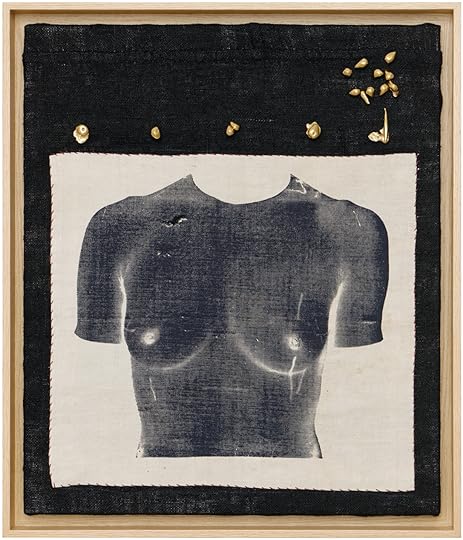 Zohra Opoku, “May you be gracious (and) may Hapi come for me (so that) I may have power over plants. I am this one of your body forever,” 2023. Screenprint on linen
Zohra Opoku, “May you be gracious (and) may Hapi come for me (so that) I may have power over plants. I am this one of your body forever,” 2023. Screenprint on linen  Zohra Opoku, “To me belongs mankind, given wholly to me . . .,” 2021. Indigo-dyed linen, monotype print, screenprint, thread
Zohra Opoku, “To me belongs mankind, given wholly to me . . .,” 2021. Indigo-dyed linen, monotype print, screenprint, threadAll works courtesy the artist and Mariane Ibrahim, Chicago
Eshun: I’ve never read the Book of the Dead. What’s in it that’s captivating for you?
Opoku: What I love is that you insist on your own truth. You insist on your own authentic being. While you’re entering the afterlife, you have to be honest in front of the council of deities, that you have not done anything wrong, let’s say, which would harm your path into the afterlife on the journey to a new existence.
The translation is so poetic, so beautiful. Then I realized that the tomb paintings, or the drawings in the papyrus, have a lot of poetic elements, corresponding with the words I was reading. That’s why I was very interested in bringing what I liked most in the text into the titles. I’m not very good in doing titles myself, so it was great to have the opportunity to use something that sounds so imaginative and captured the energy of a work. It also took, of course, a lot of reading and understanding what goes well with the piece I wanted to give a title to. That was probably the most important part—that it reads almost like a poem.
Eshun: That’s absolutely the case. The titles are brilliant, such as this one: “I am the terror in the storm who guards the great one [in] the conflict. Sharp Knife strikes for me. Ash god provides coolness for me.” They are mysterious and poetic. But also, the works aren’t illustrative, they are in conversation with these words from thousands of years ago. It seems an extraordinary connection you’ve made with, I suppose, a way of looking at life and a way of looking at death that are contained within that book.
Opoku: When you really digest something, whether positive or negative, something comes out of it. You don’t see it when you start the process, but sometimes, I’m impressed with the result. It’s probably for the best, what happened to me, because I had to go through it, and I had to actually work out a lot in my life. I think by taking time, so much more depth can be achieved, more knowledge and connection. That’s what I appreciate about this body of work—it gave me space to develop my being within a progression.
This article originally appeared in Aperture, issue 252, “Accra.”
September 12, 2023
Inside the New Photography Center Energizing Accra’s Art Scene
One recent Friday morning, in the library at the Dikan Center, Nana Asomani and his friend and colleague Tiana switched from looking at their computer screens to conversations about some work on which they are collaborating. Both had traveled from different parts of Accra to experience the newly opened photography center. At least once a week, they visit to flip through the thousands of books organized floor to ceiling in the center’s impressive library. It is an oasis in a city as fast-paced and noisy as Accra—not long ago, this institution existed only as an idea.
In the last few years, the cultural scene in Ghana has witnessed enormous growth thanks to initiatives by individuals, collectives, and the government. The contemporary art world has expanded with the emergence of spaces such as the Savannah Centre for Contemporary Art; its sister institutions, Red Clay and Nkrumah Voli-ni, in the northern town of Tamale; Artemartis, an Accra-based contemporary art collective and agency; and Accra’s artist-run Compound House Gallery, which supports and promotes contemporary art practices in Ghana. Recently, in December 2022, the internationally known painter Amoako Boafo opened dot.ateliers in Accra. This multipurpose three-story structure, down the road from the Dikan Center, houses a studio, gallery, café, and library, as well as a space for art residencies.


The Ga people of Greater Accra say “loo pii fiteee wonu,” which translates as “too much meat does not spoil the soup.” This idea explains why the creation of the Dikan Center is exciting—the institution adds variety to the growing number of artistic spaces the country’s creative community needs. It expands on existing projects outside of Accra, such as the Nuku Studio’s Center for Photographic Research and Practice, established in 2015 by the photographer Nii Obodai and formally opened in Tamale in 2018. The studio is famous for the Nuku Photo Festival Ghana, which gathers both local and international image makers and visual artists of all levels. A recent photography exhibition there focused on life in northern Ghana and presented a range of photographers.
Dikan means “take the lead,” which is something the center’s founder, Paul Ninson, appears keen to do.
Dikan, an expression from Twi, one of many Ghanaian languages, means “take the lead,” which is something the center’s founder, Paul Ninson, appears keen to do. In 2019, while studying at the school of the International Center of Photography, New York, Ninson decided to set up Dikan. At that time, he was collecting photography books in the United States, an endeavor that grew into a vision of building a photography library in Ghana to share with young people carving their own paths as image makers. The library project, funded via a crowdfunding campaign organized by Brandon Stanton, founder of the popular Instagram account Humans of New York, required the shipping of thousands of books from the United States to Accra. (There are an estimated thirty thousand books owned by the center.)
 Aperture Magazine Subscription 0.00 Get a full year of Aperture—and save 25% off the cover price. Your subscription will begin with the summer 2023 issue, “Being & Becoming: Asian in America.”
[image error]
[image error]
Aperture Magazine Subscription 0.00 Get a full year of Aperture—and save 25% off the cover price. Your subscription will begin with the summer 2023 issue, “Being & Becoming: Asian in America.”
[image error]
[image error] 
In stock
Aperture Magazine Subscription $ 0.00 –1+ View cart DescriptionSubscribe now and get the collectible print edition and the digital edition four times a year, plus unlimited access to Aperture’s online archive.
 Paul Ninson, founder and executive director of Dikan Center, April 2023
Paul Ninson, founder and executive director of Dikan Center, April 2023The Dikan Center, which in addition to its library also functions as a studio, a classroom for photography workshops, and an exhibition space, officially opened in December 2022 with Ahennie, a photography exhibition featuring images by Ninson and Emmanuel Bobbie, affectionately known as Bob Pixel. Two months prior, the center soft-launched with Bob Pixel’s first solo exhibition, a retrospective titled Wo Nim Biribi? (Asante Twi for “Do you know something?”), which celebrated the life and work of the affable photographer, who passed away in 2021. Last March, the center opened 1957: Freedom & Justice, an exhibition commemorating sixty-six years of Ghana’s independence from British rule, where visitors heard E. T. Mensah’s “Ghana Freedom” and the famous “At long last, Ghana is free forever” portion of Kwame Nkrumah’s independence declaration speech playing on a loop through the speakers connected to a video piece. On the white walls were framed photographs from the 1957 Independence Day celebrations in different parts of the country.
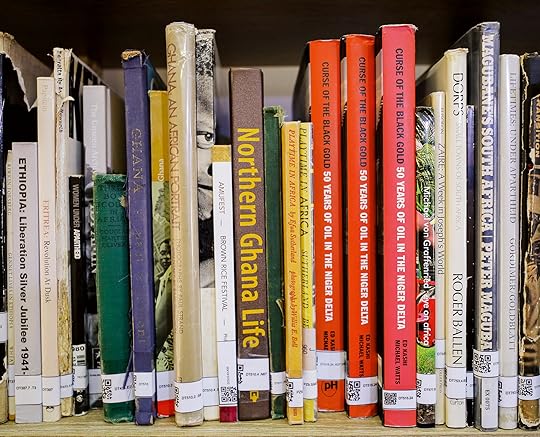
 Dikan Center, Accra, April 2023
Dikan Center, Accra, April 2023Photographs by Francis Kokoroko for Aperture
The center’s work seems to just be getting started, and photographers are taking advantage of the opportunities offered for education, exhibitions, and research. There are hardly any places like Dikan in Accra. The photographer Ernest Ankomah imagines that the space, beyond exhibiting work by members of Ghana’s creative community, might someday serve as a repository for his works, “preserving them for future generations to enjoy.” He reckons that as Africa’s biggest photography library, Dikan is a “vital resource to gauge the extent to which the African story has been told.”
Advertisement
googletag.cmd.push(function () {
googletag.display('div-gpt-ad-1343857479665-0');
});
Soon, Dikan will host film screenings and social events aimed at gathering the city’s visual-arts community together. The organization will also roll out programs and workshops. The first of them, Women Picturing Africa, a women-only workshop with the photographer Jessica Sarkodie, was held last spring. Ninson hopes that through such collaborations, with artists both in Ghana and beyond, young people can gain a visual education and take charge of telling African stories.
This article originally appeared in Aperture, issue 252, “Accra.”
September 8, 2023
Sofia Coppola on the Photographs that Inspired Her Films
This article originally appeared in Aperture, issue 231, “Film & Foto,” summer 2018.
“I never thought I would be a filmmaker. It wasn’t something I ever planned,” Sofia Coppola recently told the Guardian. “I felt frustrated at art school. I had so many interests—design, photography, music.” By turning to film she no longer had to choose. The form allowed Coppola to engage all her passions, especially photography, which has been central to shaping her cinematic language. From Coppola’s debut with The Virgin Suicides (1999) to Lost in Translation (2003) to Marie Antoinette (2006), the filmmaker has turned to the history of photography for inspiration for the interiors, costumes, and atmosphere of her films. Storyboards, replete with photographic references, were key to Coppola’s most recent—and controversial—film, the Civil War–era The Beguiled (2017), for which she won the Best Director Award at last year’s Cannes Film Festival. Each of her six feature-length films is visually distinctive, and yet it’s possible to identify in all of them a directorial signature, one that might be characterized by visual calm and compositional clarity.
For Aperture’s summer 2018 issue, “Film & Foto,” writer Philip Gefter sat down with Coppola at her home in Lower Manhattan to discuss the influence of photography on her filmmaking. On the walls hung a number of framed photographs: a William Eggleston of a girl lying in the grass holding a Brownie camera; a Tina Barney from the series Theater of Manners (1997); a Lee Friedlander nude; an Andy Warhol polaroid of Tina Chow. These pictures provided clues not only about Coppola’s knowledge of photography, but also about the subtlety of her sensibility—and became a starting point for their conversation about the look and feel of film.
 Guy Bourdin, Untitled, for Charles Jourdan, Fall 1977
Guy Bourdin, Untitled, for Charles Jourdan, Fall 1977
© The Guy Bourdin Estate
Philip Gefter: I wonder if you think that there is a tension between photography and film—the still image versus the moving image. Is photography threatened by film? Will video render the still image extinct?
Sofia Coppola: For me, photography and film are two totally different things. My filmmaking begins with images from photography, so I think of it as a starting point for making a film. I love photographs.
Gefter: Yes, I can see that by looking around the room. You mentioned, too, that you have a print upstairs by Helmut Newton of Charlotte Rampling, nude, sitting on a table; also, a picture by Larry Sultan of his father swinging a golf club indoors. So, obviously, you collect photographs.
Coppola: But not in a serious way.
Gefter: Did you study photography or film?
Coppola: I went to CalArts in the fine art program. I wanted to be a painter but I wasn’t good at it, and my teacher wasn’t encouraging, so I went to ArtCenter, in Pasadena, where I met Paul Jasmin, who taught photography. I sat in on his classes. Then I started spending time in Japan, where a kind of girly snapshot photography was popular in the early ’90s. A friend of mine had a magazine called Dune, and he would hire me to do little fashion jobs in Tokyo—snapshot-like pictures of my girlfriends. I never had the patience to learn very much technically, but I could take snapshots. That’s the extent of it.
 Still from The Virgin Suicides, 1999
Still from The Virgin Suicides, 1999
Courtesy Paramount Pictures
 Bill Owens, Eighth Grade Graduation Dance, 1973
Bill Owens, Eighth Grade Graduation Dance, 1973Courtesy the artist
Gefter: Your first film, The Virgin Suicides, was about teenage girls. How did you make the transition from taking snapshot- like photographs to making movies?
Coppola: Paul Jasmin encouraged me. He thought I had a point of view that was worthwhile, and Dad [Francis Ford Coppola] was always talking about writing. I wasn’t planning on being a filmmaker, but when I read Jeffrey Eugenides’s novel The Virgin Suicides (1993), I loved it and thought I would try adapting it. I ended up writing the script and putting a book of visual references together—photographs—to show how I wanted to make the film.
Gefter: Where did the visual references come from?
Coppola: My relationship with photography started as a teenager in the ’80s, looking at fashion magazines. I would also go to art fairs with my mother. Mom encouraged me to start collecting photography because it was the more affordable art at that time. At one art fair, I first saw the photographs of Bill Owens—his series on suburbia—so when I started working on Virgin Suicides those Bill Owens pictures became a reference. I bought one print—an image of girls at a school dance with stars hanging from the ceiling. That picture was definitely in my mind when I worked on the film.
Gefter: And, so, the book of photographs you put together—how did you use it for the look of the film?
Coppola: I made these color-xerox books, which included Bill Owens’s photographs from Suburbia (1973); also ’70s Playboy photography, with the nature girl, soft style; and Eggleston colors. The story in the film is a memory, recreated in faded snapshots. I worked with Ed Lachman, the cinematographer, showing him photographs of what I wanted the film to feel like. That’s how I start every movie, sitting with the cinematographer and the art department, looking at photographs, and saying, “This is the look or feeling,” so everyone is informed by it. It’s always the starting point for me, the images.
 John R. Hamilton, Clint Eastwood, Breakfast in Bed, 1958
John R. Hamilton, Clint Eastwood, Breakfast in Bed, 1958© the artist
Gefter: You and Harris Savides, the cinematographer, worked together on two films, Somewhere (2010) and The Bling Ring (2013). I heard you would come up with a master shot that was almost photographic: the camera didn’t move as a person walked through the frame.
Coppola: In Somewhere, it was a kind of exercise to make the most minimal movie we could make. We wanted the shots to be as simple as possible. The part I like least about filmmaking is coverage, where it becomes like a math problem to figure out all the camera angles and how they add up. You can have too many cameras and do too many shots out of insecurity, just to make sure you have the scene. So to be elegant and poetic—we were trying to be as simple as we could. I love it when the camera doesn’t move very much. For Somewhere, the first image I had in mind when working on that script was a Bruce Weber photograph of Matt Dillon in bed, and also a 1958 picture by John R. Hamilton of Clint Eastwood in bed having room service in a hotel room.
Gefter: Of course, Somewhere was about a young actor living in a hotel—the Chateau Marmont. And weren’t Paul Jasmin’s pictures also a visual influence for Somewhere?
Coppola: Yeah, Paul Jasmin has two books—Lost Angeles (2004) and California Dreaming (2010). He took a lot of photographs of young actors in LA, so the movie has that feeling, and the color—just being aware of that California sun, but in a faded way.
 Larry Sultan, Dad on Bed, 1984
Larry Sultan, Dad on Bed, 1984Courtesy the Estate of Larry Sultan, MACK Books, and Casemore Kirkeby, San Francisco
Gefter: Lost in Translation, which takes place in Tokyo, has a completely different look and feel. What were your source photographs for that film?
Coppola: The picture by Larry Sultan of his father standing inside golfing, or putting, from his series Pictures from Home (1982–91). There’s a scene with Bill Murray putting with a golf iron in the hotel room.
Gefter: Also Bill Murray sitting on the bed in his hotel room, which seems like a direct reference to another Sultan image, too.
Coppola: That one is very much like Bill sitting on the bed in the movie. So I must have had that in my mind.
I tape photographs right into the script, so when we’re shooting I have direct visual references.
Gefter: How about the look of Marie Antoinette, which is so different from your other films?
Coppola: Marie Antoinette was very fanciful, decorative, and elaborate; I pulled this photograph by Guy Bourdin as a Marie Antoinette reference. In the opening shot of the film, she is lying down like this, eating cake.
Gefter: It looks so much like the movie.
Coppola: Usually, I love not very saturated colors. That’s something in my films—I always want low contrast. But not always. It depends on the subject matter because when we made Bling Ring it was really garish, and it was this awful kind of Us Weekly subject.
 Still from Marie Antoinette, 2006
Still from Marie Antoinette, 2006© Sony Pictures Entertainment and courtesy Photofest
Gefter: There’s a paparazzi aesthetic to Bling Ring, a kind of harsh light that seems appropriate to the subject matter—teenagers robbing celebrities’ homes.
Coppola: Appropriate to that world. That was the only film I shot on digital. Everything else has been on film. I feel like they’re two different media, digital and photographic film. Film just has a different quality.
Gefter: Can you talk about the difference in quality?
Coppola: You know, it’s funny, they always say digital can do the same thing as film, but to me it’s like the difference between acrylic and oil.
 Mood board for The Beguiled, 2016
Mood board for The Beguiled, 2016Courtesy Sofia Coppola
Gefter: That’s a good analogy. What about your most recent film, The Beguiled, which takes place during the Civil War? That was definitely shot on film.
Coppola: Oh, The Beguiled. Whenever I start writing, I think about the color palette and the way it looks, so I thought about going back to The Virgin Suicides with this kind of faded, gauzy blending, these girls all blending together, which reminds me of a very feminine, pastel world. I’m trying to think about actual photographs. Anne Ross, my production designer, and I looked at Roman Polanski’s Tess (1979) for the look of it.
Gefter: I know that you used mood boards in The Beguiled. Can you tell me what they do for you and how you use them?
Coppola: To me that’s the most fun and inspiring part, just to start putting images together that give me ideas for shots. I tape photographs right into the script, so when we’re shooting I have direct visual references. For The Beguiled, there’s an Eggleston picture of two girls talking on a sofa, in color, that I showed Philippe Le Sourd, the DP. I said, “This is what I had in mind for that,” and then we designed the shot from there.
Gefter: I love that you tape pictures to the script.
Coppola: They all have color printouts taped in.
Gefter: Do you think you’re more grounded in the visual than the verbal?
Coppola: Definitely. With everything, I’m definitely visually based. I can only remember things by where I see them. That’s what I like about filmmaking. It’s putting images together. I love making collages, so it’s an extension of that.
 William Eggleston, Untitled, 1973
William Eggleston, Untitled, 1973© Eggleston Artistic Trust and courtesy David Zwirner, New York, London, and Hong Kong
Gefter: The mood boards are collages.
Coppola: I know fashion designers use mood boards too, but mine start with making these little photobooks where the images kind of come together, and you can start to see the whole story. With The Beguiled, we had different boards for each section. There are three acts to the story. The first section is dreamy and soft and very feminine, and we wanted it to feel unthreatening so that you have no idea where the story is going or how it is going to turn. The last section gets more Gothic and dark and the angles are more extreme, with those white dresses and dark backgrounds. Anne had the idea of making the walls darker, so everything gets darker. When we make the boards, you can see the different sections of the movie and see where you’re going in the different acts. It helps because you’re shooting out of order, so you can bring up these boards on set, the collages, and they remind you of the tone of the part of the movie the scene is in.
Gefter: Does Anne make the mood boards or do you do it together?
Coppola: She put those together. I like to do that too, and if I’m working on a short—I did a little Cartier commercial—we make mood boards, and I can show people what I have in mind so everyone working on it gets it. There’s something about the sum total of all the images, and that’s what a movie is—grouping together these images and having an overall feeling. It helps the team working on it, too. I’m not a great photographer, but I like it when I get my pictures back and I can lay them out and make a collage or a book. I enjoy the layout part, so maybe it relates to my filmmaking—getting a feeling from the totality of all the images, as opposed to just one image telling the whole story.
This article originally appeared in Aperture, issue 231, “Film & Foto,” summer 2018. Sofia Coppola: Archive was published by MACK in September 2023.
Related Items

Aperture 231
Shop Now[image error]
Aperture Magazine Subscription
Shop Now[image error]September 7, 2023
Carlos Idun-Tawiah’s Retro-Inspired Vision of Ghanaian Youth
Family albums are the starting point of the series Sunday Special (2022) by Carlos Idun-Tawiah, who draws on the semiotics of earlier Ghanaian photographers’ work to create his own visual language. It’s a language that resonates with a bygone time but is also deeply contemporary. Incorporating his experience with fashion photography, from Vogue to GQ to Harper’s Bazaar, Idun-Tawiah’s photographs emit the highly stylized tone of editorial spreads and, at the same time, the intimacy of personal pictures of friends and loved ones.
Idun-Tawiah who is based in Accra, was born in 1997, exactly forty years after Ghana’s independence. His vision is steeped in nostalgia—both personal (depictions of young people attending school, visiting the barber, playing soccer, or going to church) and collective (poses, fashions, and hairstyles). He conjures visceral recollections held in his memory yet out of reach. The photographer does this not just through his aesthetic approach but by constructing whole stories, biographies, and characters, by bringing in costumes and sets, and by having his subjects freely inhabit the roles they are playing. These scenes have, both in composition and intent, a multilayered and multifaceted resonance.
 Aperture Magazine Subscription 0.00 Get a full year of Aperture—and save 25% off the cover price. Your subscription will begin with the summer 2023 issue, “Being & Becoming: Asian in America.”
[image error]
[image error]
Aperture Magazine Subscription 0.00 Get a full year of Aperture—and save 25% off the cover price. Your subscription will begin with the summer 2023 issue, “Being & Becoming: Asian in America.”
[image error]
[image error] 
In stock
Aperture Magazine Subscription $ 0.00 –1+ View cart DescriptionSubscribe now and get the collectible print edition and the digital edition four times a year, plus unlimited access to Aperture’s online archive.
While images by Ghana’s twentieth-century photography pioneers typically served one purpose—documentation or representation—Idun-Tawiah’s pictures, with their self-conscious referencing and intentionality, go beyond that singular role. He describes his new work as a requiem to moments of his past, inspired by photographers from Africa’s visually rich history, such as James Barnor, Malick Sidibé, Seydou Keïta, and Felicia Abban—Ghana’s first female professional photographer— along with US photographers including Roy DeCarava, Gordon Parks, Alex Webb, and Alec Soth. He is especially interested in vernacular portraiture, and aims, he says, to put the “emotion- forward” quality of films into his pictures, using style and scenery to establish settings in which his subjects act and move freely in what he terms “photographic biopics.”
In 2007, I curated an exhibition of Barnor’s photographs at the Black Cultural Archives in London, one of the earliest shows of his work, and in 2017 I organized the first public presentation of Abban’s images, at ANO Institute of Arts and Knowledge, in Accra. I also undertook the digitization of the archives of these two artists so that young photographers would be able to draw on their work and not constantly have to look outside our own stories for inspiration, for foundation. Idun-Tawiah’s photography is not just a testament to his forebears but an expansion, a deepening. Through its beautifully drawn reflections of our being it reveals the evolution of our modernity.
 Carlos Idun-Tawiah, Hide and Seek, 2023, from the series Boys Will Always Be Boys
Carlos Idun-Tawiah, Hide and Seek, 2023, from the series Boys Will Always Be Boys  Carlos Idun-Tawiah, Mommy, Smile, 2022, from the series Sunday Special
Carlos Idun-Tawiah, Mommy, Smile, 2022, from the series Sunday Special Advertisement
googletag.cmd.push(function () {
googletag.display('div-gpt-ad-1343857479665-0');
});
 Carlos Idun-Tawiah, The Barbershop, 2023, from the series Boys Will Always Be Boys
Carlos Idun-Tawiah, The Barbershop, 2023, from the series Boys Will Always Be Boys  Carlos Idun-Tawiah, Uncle Adu’s Studio, 2022, from the series Sunday Special
Carlos Idun-Tawiah, Uncle Adu’s Studio, 2022, from the series Sunday SpecialAll photographs courtesy the artist
This article originally appeared in Aperture, issue 252, “Accra.”
Carlos Idun-Tawiah’s photographs are on view September 8-10 at the 2023 Armory Show in New York.
Aperture's Blog
- Aperture's profile
- 21 followers



